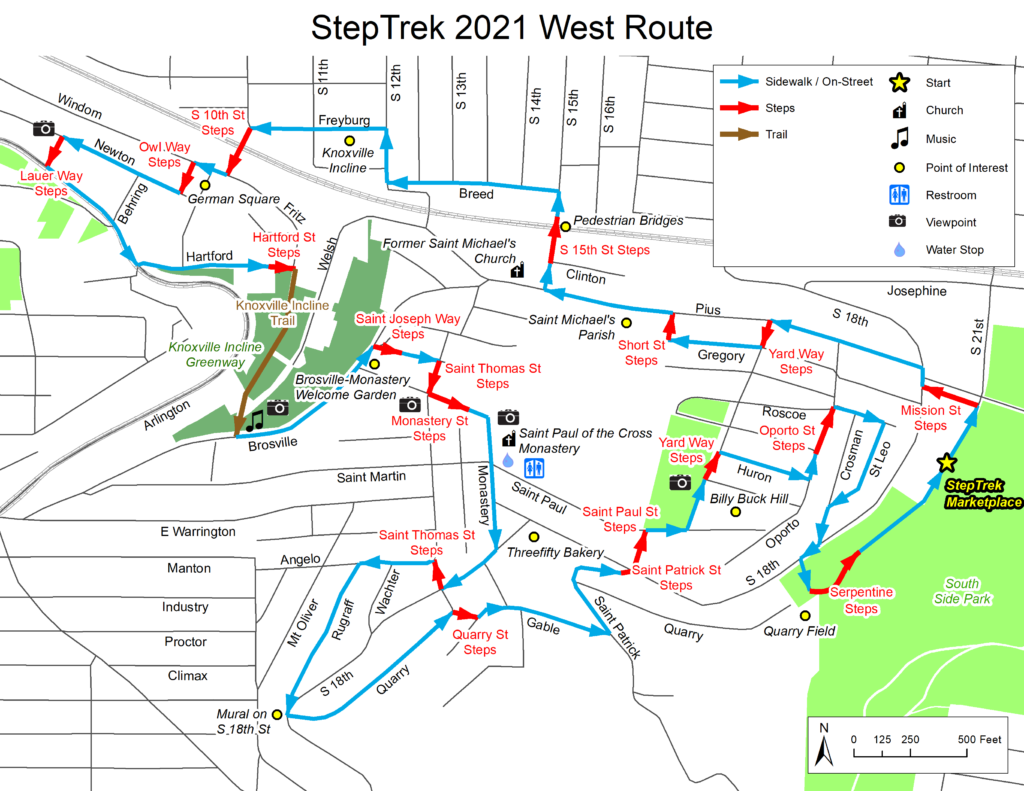Click ![]() in the top-right of the slider to make it full screen.
in the top-right of the slider to make it full screen.
 1. Pittsburgh StepTrek 2021 Gold Route
1. Pittsburgh StepTrek 2021 Gold RouteIf joining from the Black Route, begin with #5. * Denotes history or significant site.
If joining from the Black Route, begin with #5. * Denotes history or significant site.
If joining from the Black Route, begin with #5. * Denotes history or significant site.
 2. 21st annual StepTrek: Music on the Slopes
2. 21st annual StepTrek: Music on the SlopesTo help celebrate StepTrek’s coming of age, five different bands will perform at various venues throughout South Side Slopes. Four of the bands boast members who live on the South Side Flats or Slopes. Performance locations and times are listed within the route narrative. Take time to enjoy a breather and some music!
To help celebrate StepTrek’s coming of age, five different bands will perform at various venues throughout South Side Slopes. Four of the bands boast members who live on the South Side Flats or Slopes. Performance locations and times are listed within the route narrative. Take time to enjoy a breather and some music!
To help celebrate StepTrek’s coming of age, five different bands will perform at various venues throughout South Side Slopes. Four of the bands boast members who live on the South Side Flats or Slopes. Performance locations and times are listed within the route narrative. Take time to enjoy a breather and some music!
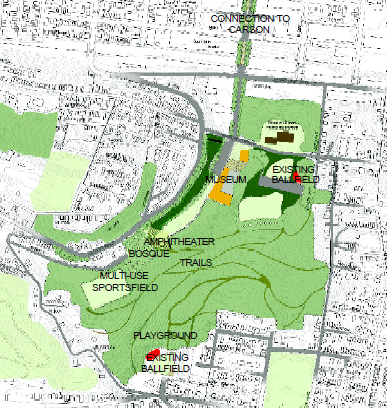 3. * South Side Park
3. * South Side ParkEfforts continue to reclaim a 64 acre park that extends from Josephine St. below to the heights of the Slopes. In this wooded hillside are streams, ball fields and footpaths. Volunteers have removed invasive plants and helped build its trails. Helping trim the aggressive knotweed and vines are a small herd of bovids, brought in for a few weeks as part of the Annual Goat Fest. With funding from The Brashear Association, South Side Slopes Neighborhood Association partnered with Pittsburgh Parks Conservancy, Landforce and the Student Conservation Association to create this neighborhood asset. Friends of South Side Park manages its ongoing work.
Efforts continue to reclaim a 64 acre park that extends from Josephine St. below to the heights of the Slopes. In this wooded hillside are streams, ball fields and footpaths. Volunteers have removed invasive plants and helped build its trails. Helping trim the aggressive knotweed and vines are a small herd of bovids, brought in for a few weeks as part of the Annual Goat Fest. With funding from The Brashear Association, South Side Slopes Neighborhood Association partnered with Pittsburgh Parks Conservancy, Landforce and the Student Conservation Association to create this neighborhood asset. Friends of South Side Park manages its ongoing work.
Efforts continue to reclaim a 64 acre park that extends from Josephine St. below to the heights of the Slopes. In this wooded hillside are streams, ball fields and footpaths. Volunteers have removed invasive plants and helped build its trails. Helping trim the aggressive knotweed and vines are a small herd of bovids, brought in for a few weeks as part of the Annual Goat Fest. With funding from The Brashear Association, South Side Slopes Neighborhood Association partnered with Pittsburgh Parks Conservancy, Landforce and the Student Conservation Association to create this neighborhood asset. Friends of South Side Park manages its ongoing work.
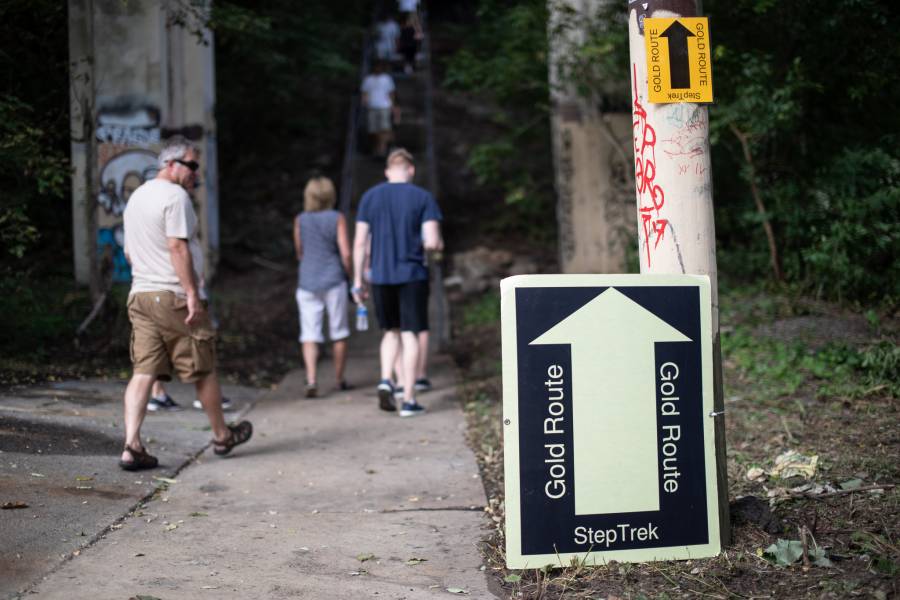 4. Mission St. Bridge & Steps
4. Mission St. Bridge & StepsUnder the bridge towering over StepTrek registration and Marketplace are the Mission St. Steps. You’ll find them under the left side of the bridge. Climb a total of 102 steps to the intersection of Mission St. and S. 18th St.
Under the bridge towering over StepTrek registration and Marketplace are the Mission St. Steps. You’ll find them under the left side of the bridge. Climb a total of 102 steps to the intersection of Mission St. and S. 18th St.
Under the bridge towering over StepTrek registration and Marketplace are the Mission St. Steps. You’ll find them under the left side of the bridge. Climb a total of 102 steps to the intersection of Mission St. and S. 18th St.
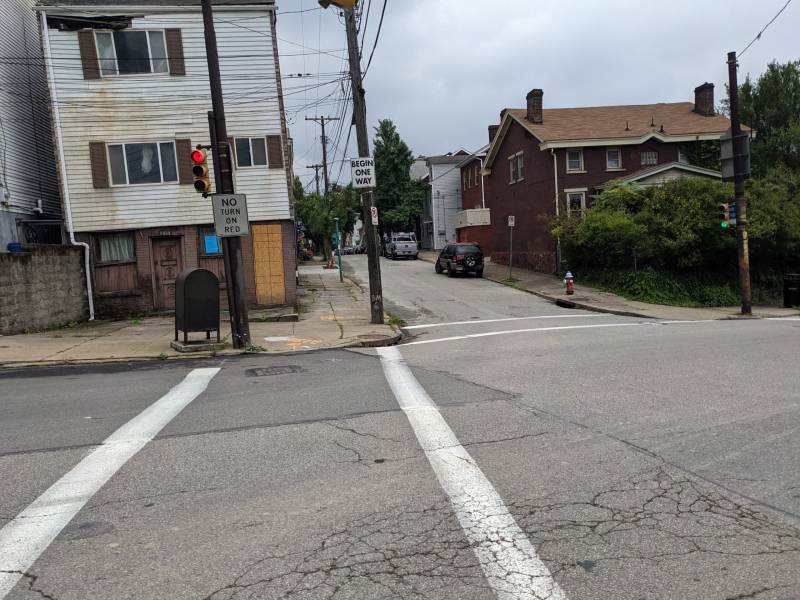 5. S. 18th St.
5. S. 18th St.Cross S. 18th St. at light to Pius St. on the opposite side.
Cross S. 18th St. at light to Pius St. on the opposite side.
Cross S. 18th St. at light to Pius St. on the opposite side.
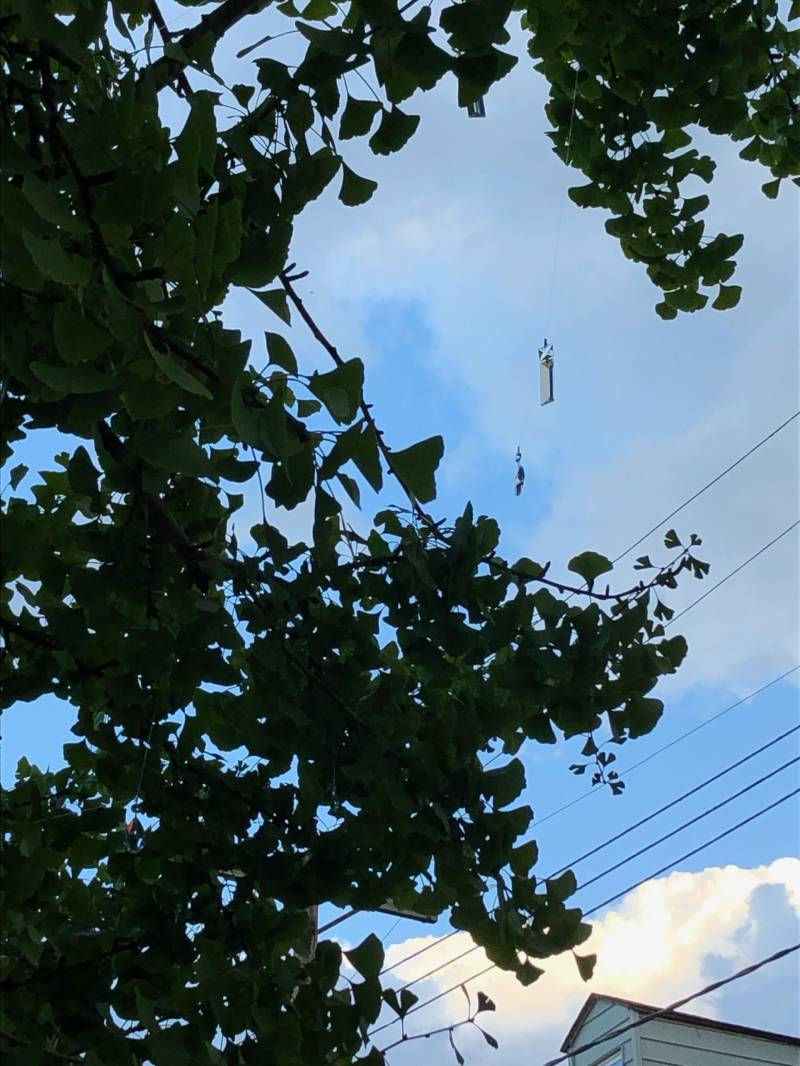 6. Pius St.
6. Pius St.Continue along left side of Pius. Residents are encouraged to add art in support of StepTrek. Hanging on a tree in front of 179 Pius are crystals hanging throughout and two COR-TEN steel birds in the shape of cardinal and a crow. A few of the larger brick buildings housed businesses that had storefronts on their ground floors. Just past 132 Pius St. are Yard Way Steps.
Continue along left side of Pius. Residents are encouraged to add art in support of StepTrek. Hanging on a tree in front of 179 Pius are crystals hanging throughout and two COR-TEN steel birds in the shape of cardinal and a crow. A few of the larger brick buildings housed businesses that had storefronts on their ground floors. Just past 132 Pius St. are Yard Way Steps.
Continue along left side of Pius. Residents are encouraged to add art in support of StepTrek. Hanging on a tree in front of 179 Pius are crystals hanging throughout and two COR-TEN steel birds in the shape of cardinal and a crow. A few of the larger brick buildings housed businesses that had storefronts on their ground floors. Just past 132 Pius St. are Yard Way Steps.
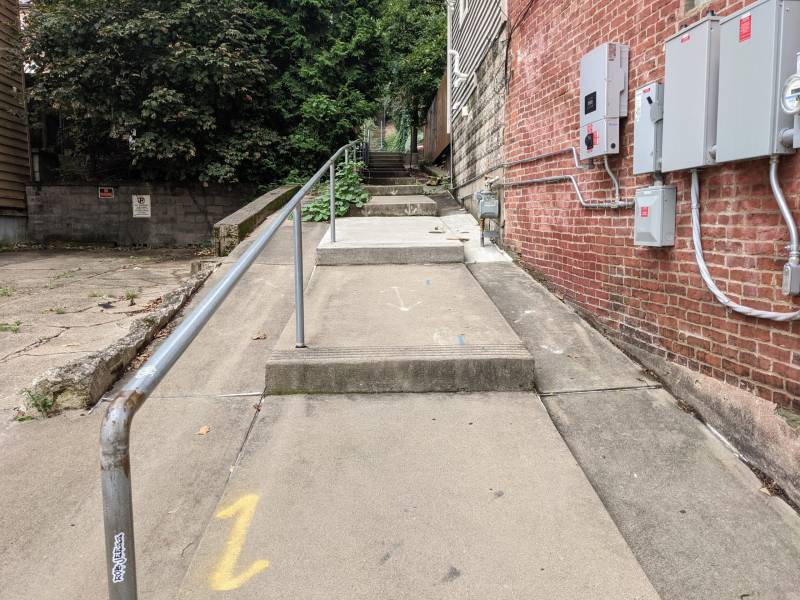 7. Yard Way Steps
7. Yard Way StepsMost of the steps on Yard Way date back to 1944 and number 314 in total. They are the longest set of stairs on this side of the Slopes. The first 13 steps were rebuilt in time for the initial StepTrek in April 2000. In addition to providing a fascinating tour of this hillside neighborhood, StepTrek encourages the city to make repairs to existing stairways for public safety. The first cross street you come to is Gregory St.
Most of the steps on Yard Way date back to 1944 and number 314 in total. They are the longest set of stairs on this side of the Slopes. The first 13 steps were rebuilt in time for the initial StepTrek in April 2000. In addition to providing a fascinating tour of this hillside neighborhood, StepTrek encourages the city to make repairs to existing stairways for public safety. The first cross street you come to is Gregory St.
Most of the steps on Yard Way date back to 1944 and number 314 in total. They are the longest set of stairs on this side of the Slopes. The first 13 steps were rebuilt in time for the initial StepTrek in April 2000. In addition to providing a fascinating tour of this hillside neighborhood, StepTrek encourages the city to make repairs to existing stairways for public safety. The first cross street you come to is Gregory St.
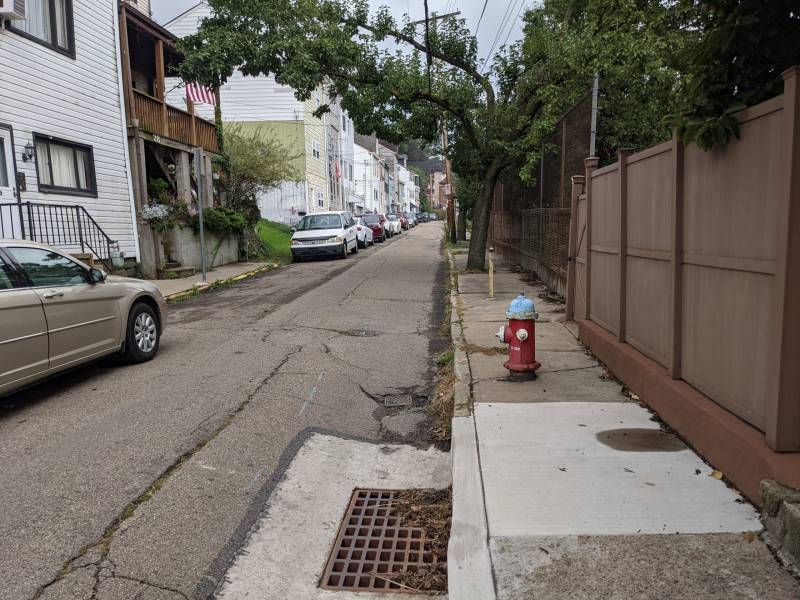 8. Gregory St.
8. Gregory St.Make right. Walk to end of street. Across on the right is a fire hydrant
and utility pole. Short St. steps are to the right between a fence and house.
Make right. Walk to end of street. Across on the right is a fire hydrant
and utility pole. Short St. steps are to the right between a fence and house.
Make right. Walk to end of street. Across on the right is a fire hydrant
and utility pole. Short St. steps are to the right between a fence and house.
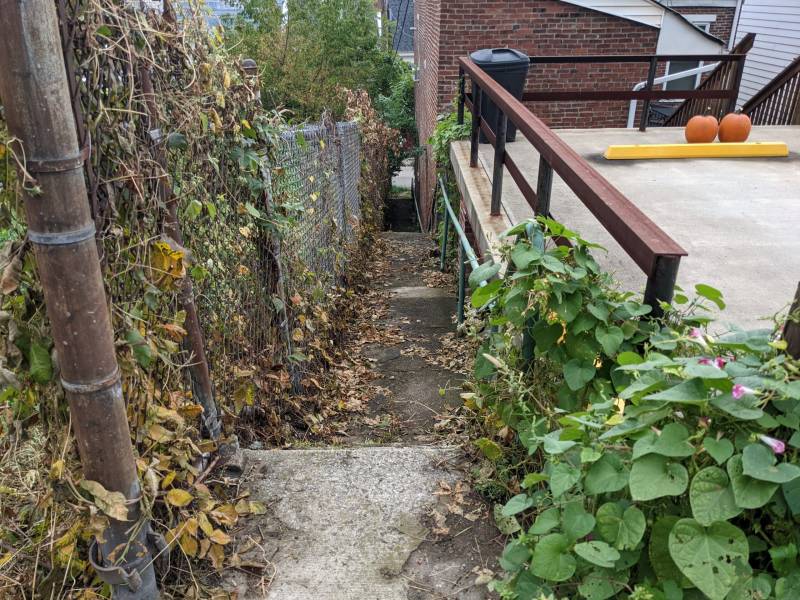 9. Short St. Steps
9. Short St. StepsTurn right and descend 21 steps to Pius St. You are now in the midst of the what was St. Michael Parish.
Turn right and descend 21 steps to Pius St. You are now in the midst of the what was St. Michael Parish.
Turn right and descend 21 steps to Pius St. You are now in the midst of the what was St. Michael Parish.
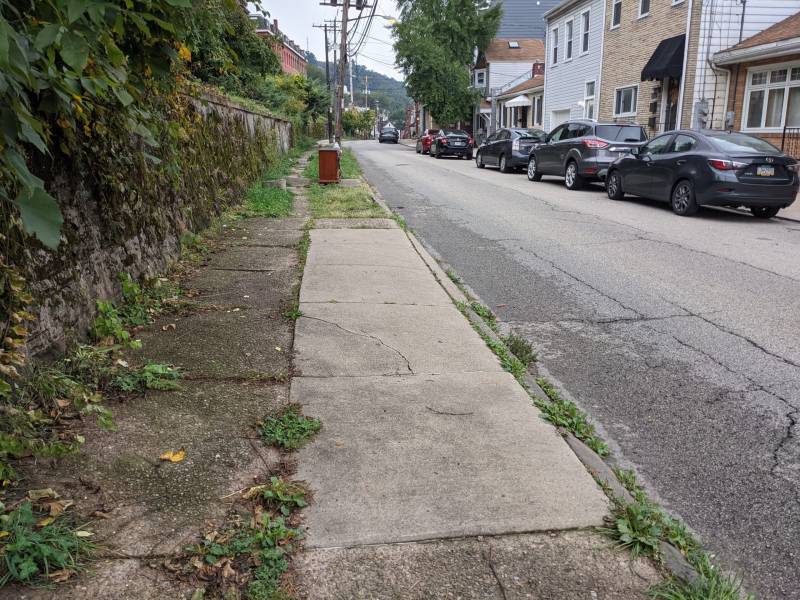 10. Pius St.
10. Pius St.Make left and keep left along Pius. The former convent at 66 Pius Street,
on the left, is now a condominium complex. The building was once part of St. Michael’s
Parish.
Make left and keep left along Pius. The former convent at 66 Pius Street,
on the left, is now a condominium complex. The building was once part of St. Michael’s
Parish.
Make left and keep left along Pius. The former convent at 66 Pius Street,
on the left, is now a condominium complex. The building was once part of St. Michael’s
Parish.
 11. * St. Michael’s Parish
11. * St. Michael’s ParishAt 44 Pius is the former St. Michael’s Madchen Schule and previous home of the Veronica’s Veil playhouse. The theater hosted a series of plays throughout the year but was most famous for its Passion play, Veronica’s Veil. Performed during Lent, it was said to be the longest running play in American community theater. These buildings were part of St. Michael’s Parish. The next building housed the Burning Bush, which offered a retreat center for quiet meditation in overnight rooms. Both buildings are part of a planned new apartment complex.
At 44 Pius is the former St. Michael’s Madchen Schule and previous home of the Veronica’s Veil playhouse. The theater hosted a series of plays throughout the year but was most famous for its Passion play, Veronica’s Veil. Performed during Lent, it was said to be the longest running play in American community theater. These buildings were part of St. Michael’s Parish. The next building housed the Burning Bush, which offered a retreat center for quiet meditation in overnight rooms. Both buildings are part of a planned new apartment complex.
At 44 Pius is the former St. Michael’s Madchen Schule and previous home of the Veronica’s Veil playhouse. The theater hosted a series of plays throughout the year but was most famous for its Passion play, Veronica’s Veil. Performed during Lent, it was said to be the longest running play in American community theater. These buildings were part of St. Michael’s Parish. The next building housed the Burning Bush, which offered a retreat center for quiet meditation in overnight rooms. Both buildings are part of a planned new apartment complex.
 12. * St. Michael Church
12. * St. Michael ChurchThe influence of the church was strong in the Slopes. St. Michael parish started in a house in 1848 where the church front now stands. Designed by Charles Bartberger of Stuttgart, Germany, the church was built between 1855 and 1860 on land donated by German immigrants. The surrounding land reminded them of the Rhine River valley. Though it has a gothic spire, the overall style is Rhineland Romanesque Rival similar to rural Bavarian churches. The church was closed through a consolidation of parishes and has been redeveloped into condominiums.
The influence of the church was strong in the Slopes. St. Michael parish started in a house in 1848 where the church front now stands. Designed by Charles Bartberger of Stuttgart, Germany, the church was built between 1855 and 1860 on land donated by German immigrants. The surrounding land reminded them of the Rhine River valley. Though it has a gothic spire, the overall style is Rhineland Romanesque Rival similar to rural Bavarian churches. The church was closed through a consolidation of parishes and has been redeveloped into condominiums.
The influence of the church was strong in the Slopes. St. Michael parish started in a house in 1848 where the church front now stands. Designed by Charles Bartberger of Stuttgart, Germany, the church was built between 1855 and 1860 on land donated by German immigrants. The surrounding land reminded them of the Rhine River valley. Though it has a gothic spire, the overall style is Rhineland Romanesque Rival similar to rural Bavarian churches. The church was closed through a consolidation of parishes and has been redeveloped into condominiums.
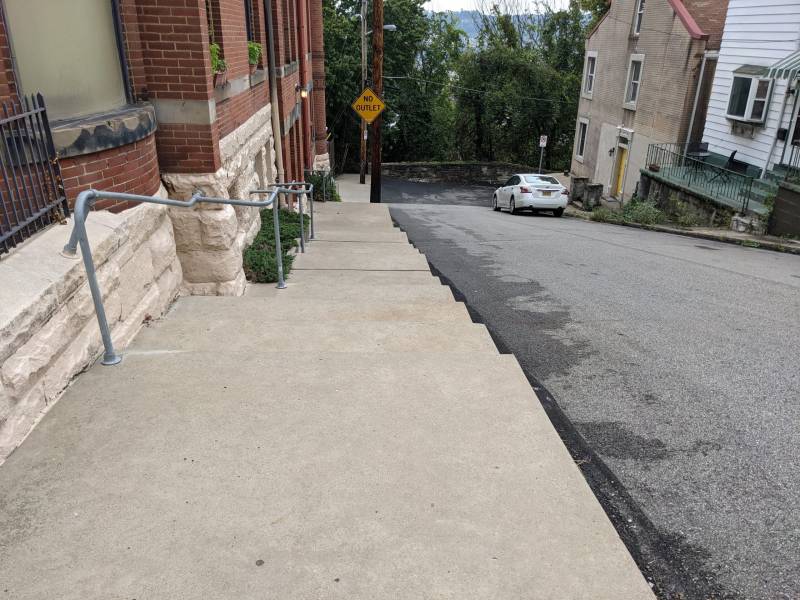 13. S. 15th St.
13. S. 15th St.Make right before St. Michael Church and descend the 26 steps along left side to Clinton St.
Make right before St. Michael Church and descend the 26 steps along left side to Clinton St.
Make right before St. Michael Church and descend the 26 steps along left side to Clinton St.
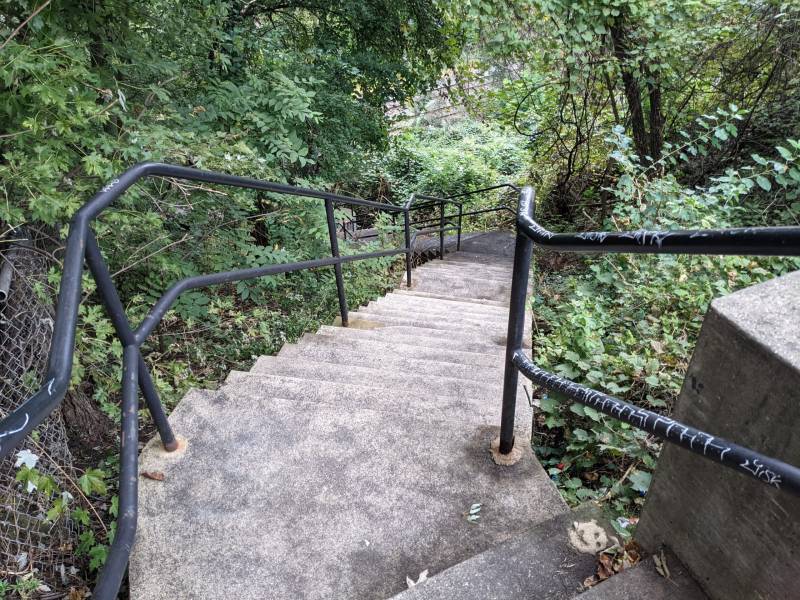 14. S. 15th St. Steps
14. S. 15th St. StepsContinue past Clinton to set of steps dropping through the trees. Descend the 60 stairs to the footbridge over the Norfolk Southern Railroad.
Continue past Clinton to set of steps dropping through the trees. Descend the 60 stairs to the footbridge over the Norfolk Southern Railroad.
Continue past Clinton to set of steps dropping through the trees. Descend the 60 stairs to the footbridge over the Norfolk Southern Railroad.
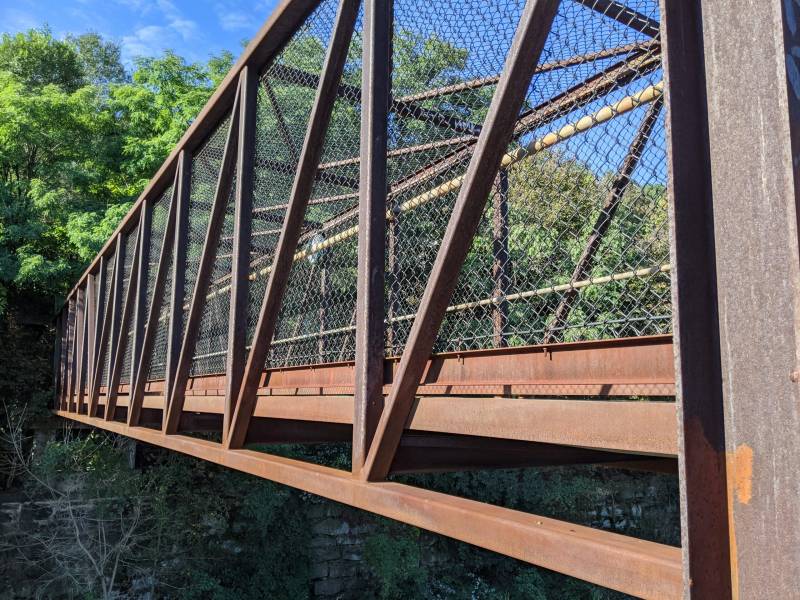 15. * Pedestrian Bridges
15. * Pedestrian BridgesAt the request of SSSNA & Slopes residents, the City and railroad completed this footbridge and the other at S. 10th St. in 2002. The trestle is made of the same COR-TEN steel as the UPMC (former U.S. Steel) tower downtown. The brown rust serves as a protective coating over the steel frame. The bridges reinstated pedestrian access between the Slopes and Flats. Another SSSNA effort brought safety lighting to the two bridges. At the end of the bridge, descend 59 steps.
At the request of SSSNA & Slopes residents, the City and railroad completed this footbridge and the other at S. 10th St. in 2002. The trestle is made of the same COR-TEN steel as the UPMC (former U.S. Steel) tower downtown. The brown rust serves as a protective coating over the steel frame. The bridges reinstated pedestrian access between the Slopes and Flats. Another SSSNA effort brought safety lighting to the two bridges. At the end of the bridge, descend 59 steps.
At the request of SSSNA & Slopes residents, the City and railroad completed this footbridge and the other at S. 10th St. in 2002. The trestle is made of the same COR-TEN steel as the UPMC (former U.S. Steel) tower downtown. The brown rust serves as a protective coating over the steel frame. The bridges reinstated pedestrian access between the Slopes and Flats. Another SSSNA effort brought safety lighting to the two bridges. At the end of the bridge, descend 59 steps.
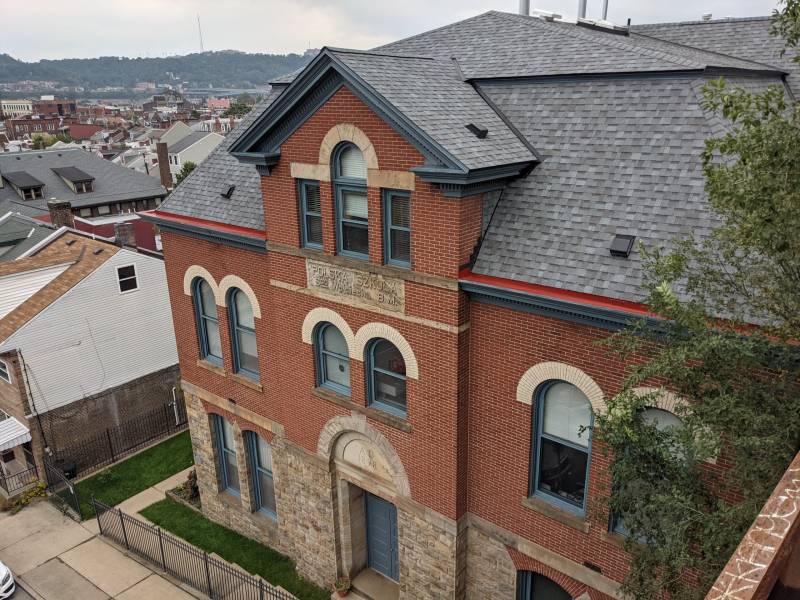 16. S. 15th St. (Cont.)
16. S. 15th St. (Cont.)To the right is the former Polska Szkola built in 1898. Continue down S. 15th St. one half block to Breed St. A couple of doors down S. 15th St., on the left, is St. Adalbert Church. This is the sole active Roman Catholic church in the South Side since the consolidation among local parishes.
To the right is the former Polska Szkola built in 1898. Continue down S. 15th St. one half block to Breed St. A couple of doors down S. 15th St., on the left, is St. Adalbert Church. This is the sole active Roman Catholic church in the South Side since the consolidation among local parishes.
To the right is the former Polska Szkola built in 1898. Continue down S. 15th St. one half block to Breed St. A couple of doors down S. 15th St., on the left, is St. Adalbert Church. This is the sole active Roman Catholic church in the South Side since the consolidation among local parishes.
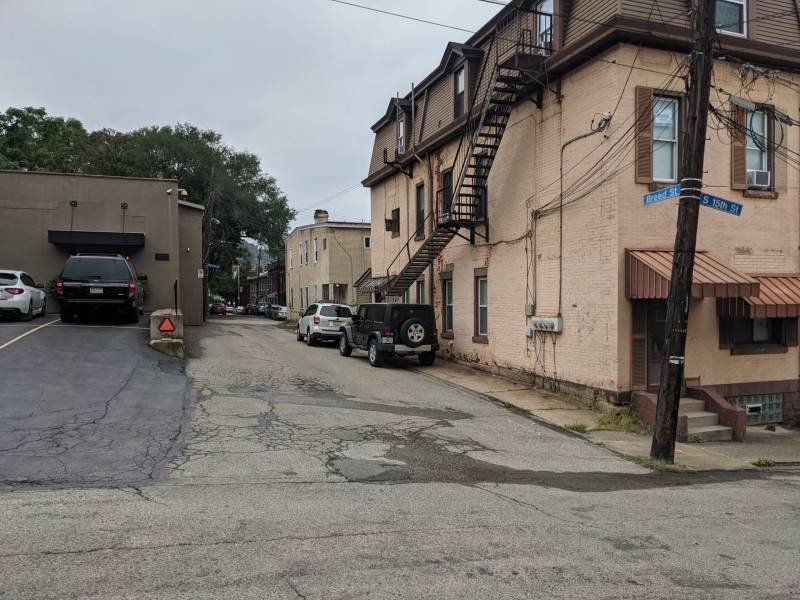 17. Breed St.
17. Breed St.Make left and walk along this shady street of mostly brick houses to S. 12th St.
Make left and walk along this shady street of mostly brick houses to S. 12th St.
Make left and walk along this shady street of mostly brick houses to S. 12th St.
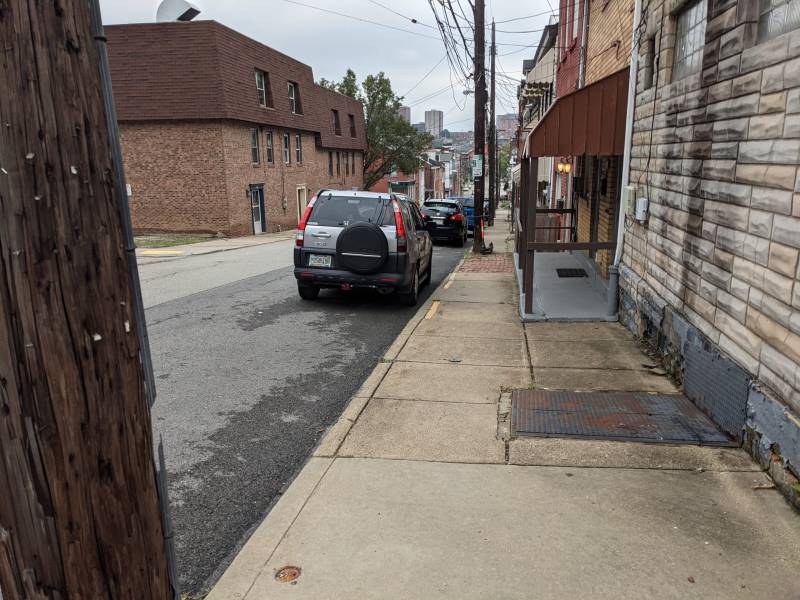 18. S. 12th St.
18. S. 12th St.Take a right and keep right as you walk to Freyburg St.
Take a right and keep right as you walk to Freyburg St.
Take a right and keep right as you walk to Freyburg St.
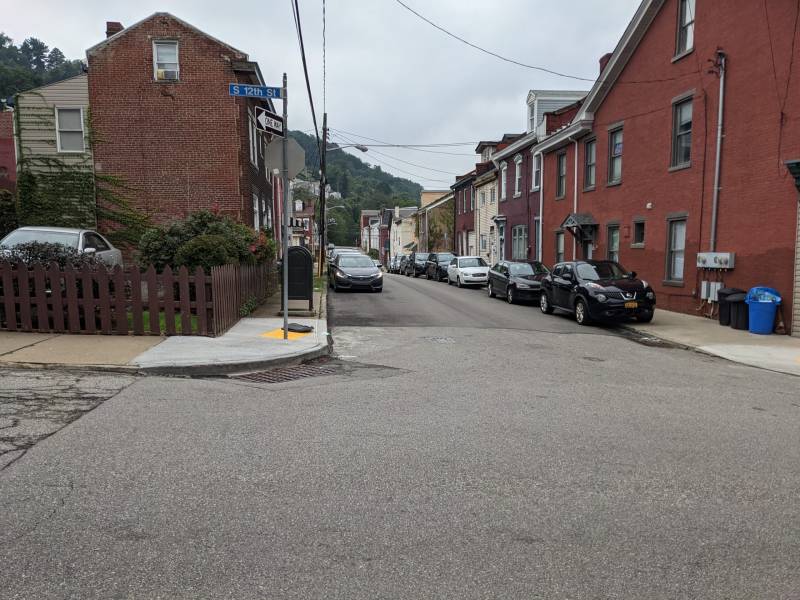 19. Freyburg St.
19. Freyburg St.Use caution as you make left and cross S. 12th St. Between 1117 and 1111 Freyburg was where a stone wall vaulted the Knoxville Incline over Freyburg on its climb to the hilltop. Its foundation remains.
Use caution as you make left and cross S. 12th St. Between 1117 and 1111 Freyburg was where a stone wall vaulted the Knoxville Incline over Freyburg on its climb to the hilltop. Its foundation remains.
Use caution as you make left and cross S. 12th St. Between 1117 and 1111 Freyburg was where a stone wall vaulted the Knoxville Incline over Freyburg on its climb to the hilltop. Its foundation remains.
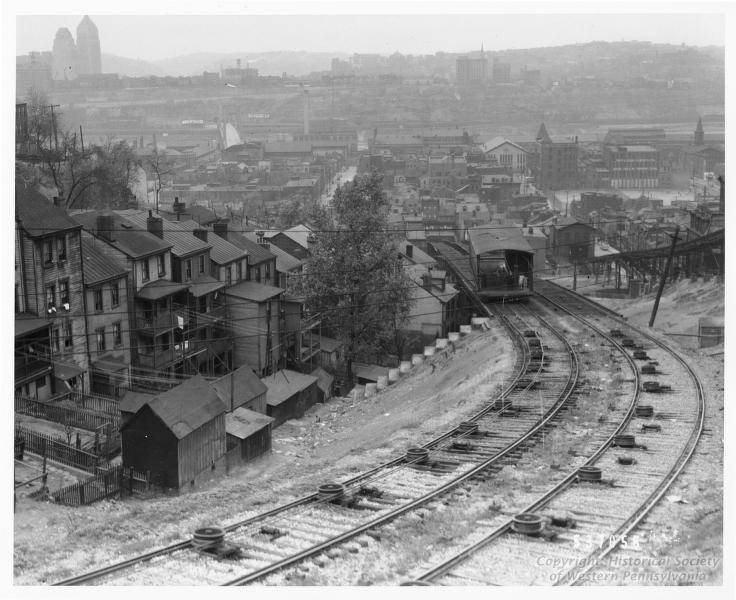 20. * Knoxville Incline
20. * Knoxville InclineThe Knoxville Incline (1889-1960) began one street down on Bradish St. It followed the hollow going uphill to Fritz St. and Allentown. A deep trough carved into the ground permitted the incline to dock at street level. Later renamed the Pittsburgh Incline, it boarded horses, wagons, carts and passengers and was the last remaining of two city inclines to curve up the hill. The track extended 2,644 feet and was the longest incline in the city. During the Depression, it cost three cents to ride. Continue on Freyburg to S. 10th St.
The Knoxville Incline (1889-1960) began one street down on Bradish St. It followed the hollow going uphill to Fritz St. and Allentown. A deep trough carved into the ground permitted the incline to dock at street level. Later renamed the Pittsburgh Incline, it boarded horses, wagons, carts and passengers and was the last remaining of two city inclines to curve up the hill. The track extended 2,644 feet and was the longest incline in the city. During the Depression, it cost three cents to ride. Continue on Freyburg to S. 10th St.
The Knoxville Incline (1889-1960) began one street down on Bradish St. It followed the hollow going uphill to Fritz St. and Allentown. A deep trough carved into the ground permitted the incline to dock at street level. Later renamed the Pittsburgh Incline, it boarded horses, wagons, carts and passengers and was the last remaining of two city inclines to curve up the hill. The track extended 2,644 feet and was the longest incline in the city. During the Depression, it cost three cents to ride. Continue on Freyburg to S. 10th St.
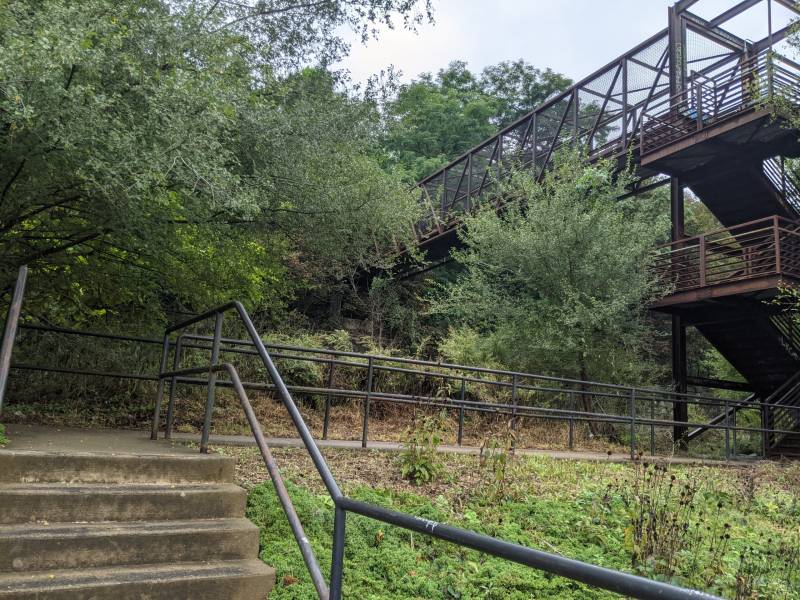 21. S. 10th St. & Steps
21. S. 10th St. & StepsMake left and climb 57 steps to S. 10th St. Pedestrian Bridge, a sister to S. 15th St. Bridge, erected in the same year. Stop mid-span and look left to view the spectacular St. Michael church on the hillside. Continue across the railroad tracks and climb 49 steps to Fritz St.
Make left and climb 57 steps to S. 10th St. Pedestrian Bridge, a sister to S. 15th St. Bridge, erected in the same year. Stop mid-span and look left to view the spectacular St. Michael church on the hillside. Continue across the railroad tracks and climb 49 steps to Fritz St.
Make left and climb 57 steps to S. 10th St. Pedestrian Bridge, a sister to S. 15th St. Bridge, erected in the same year. Stop mid-span and look left to view the spectacular St. Michael church on the hillside. Continue across the railroad tracks and climb 49 steps to Fritz St.
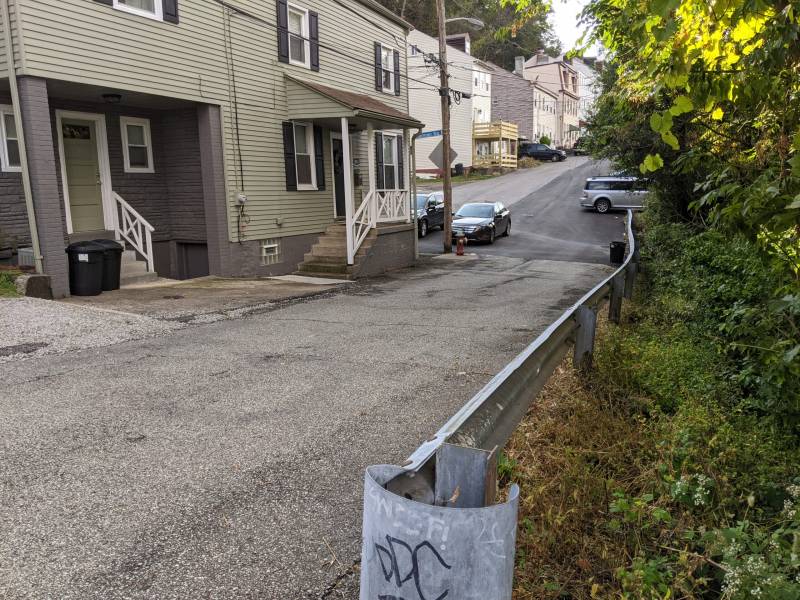 22. Fritz St.
22. Fritz St.Make right and walk 50 feet to German Square.
Make right and walk 50 feet to German Square.
Make right and walk 50 feet to German Square.
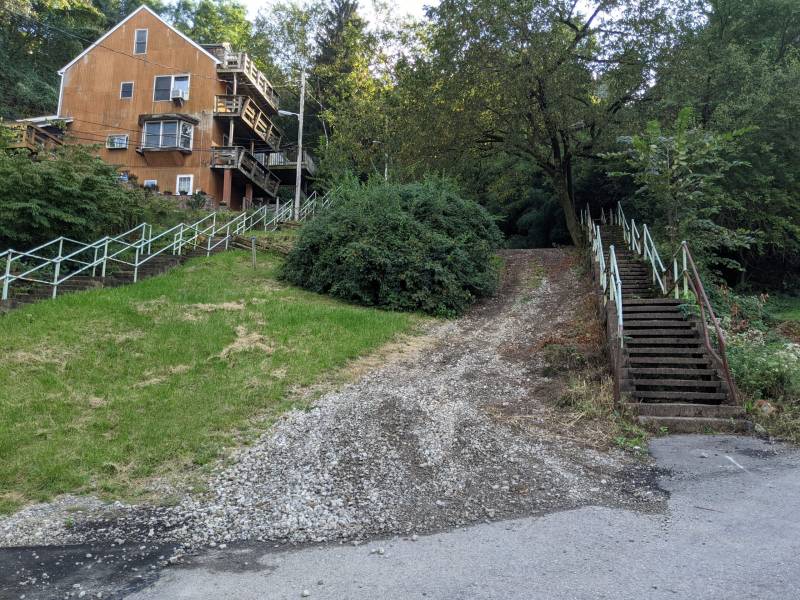 23. * German Square
23. * German SquareNamed after the German families who settled on the hillside, the square features parallel sets of steps that climb into the Slopes.
Named after the German families who settled on the hillside, the square features parallel sets of steps that climb into the Slopes.
Named after the German families who settled on the hillside, the square features parallel sets of steps that climb into the Slopes.
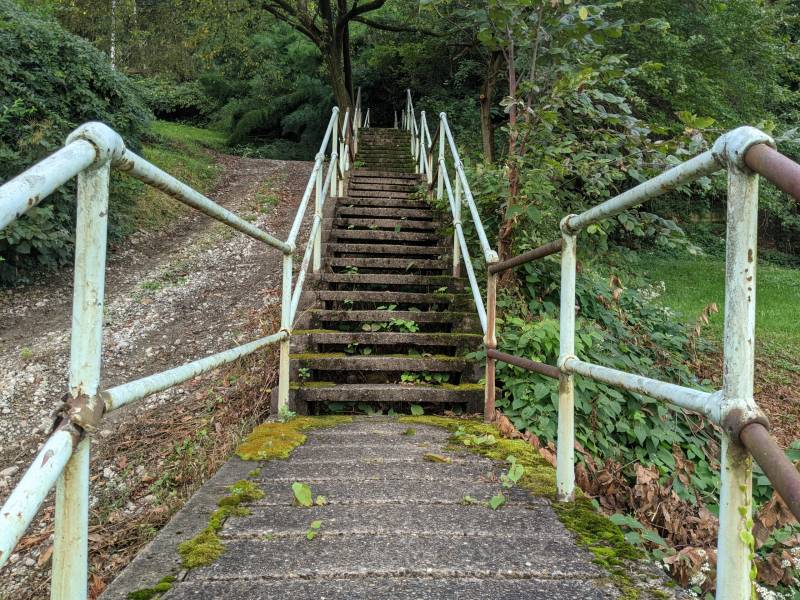 24. German Square/Owl Way Steps
24. German Square/Owl Way StepsGo to the stairway on the right and climb the 128 steps, which hook to the right, and lead to Newton St.
Go to the stairway on the right and climb the 128 steps, which hook to the right, and lead to Newton St.
Go to the stairway on the right and climb the 128 steps, which hook to the right, and lead to Newton St.
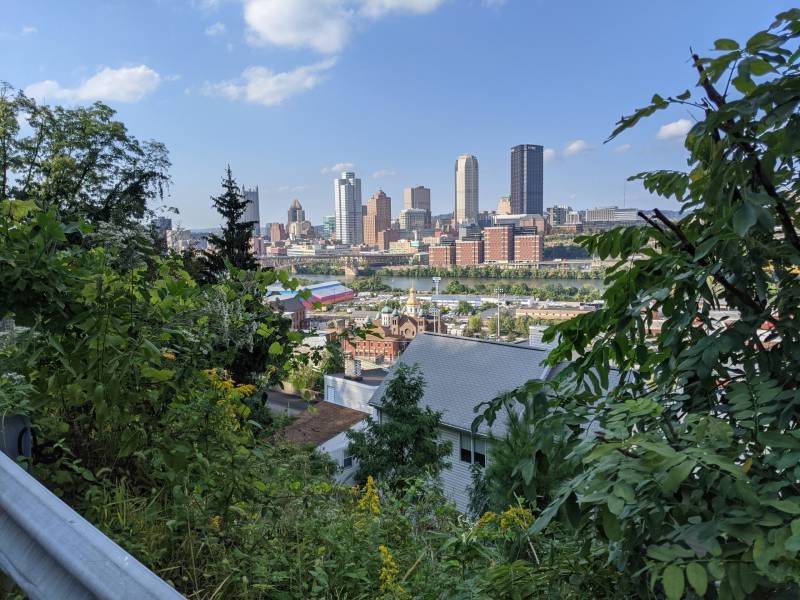 25. Newton St.
25. Newton St.Continue along the foot path to the narrow lane and Lauer Way Steps. Notice the beautiful views of South Side and downtown. That’s South Side Stadium directly below.
Continue along the foot path to the narrow lane and Lauer Way Steps. Notice the beautiful views of South Side and downtown. That’s South Side Stadium directly below.
Continue along the foot path to the narrow lane and Lauer Way Steps. Notice the beautiful views of South Side and downtown. That’s South Side Stadium directly below.
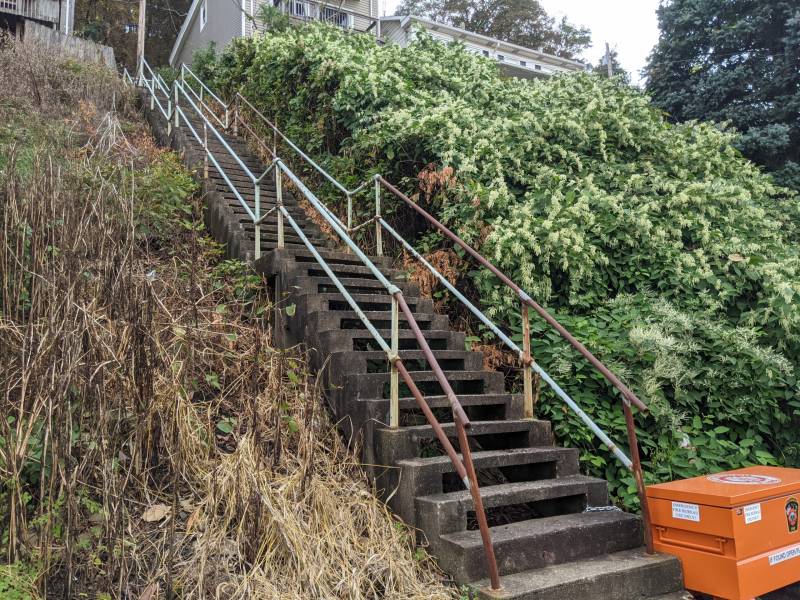 26. Lauer Way Steps
26. Lauer Way StepsTake a left and climb 95 steps to Arlington Ave.
Take a left and climb 95 steps to Arlington Ave.
Take a left and climb 95 steps to Arlington Ave.
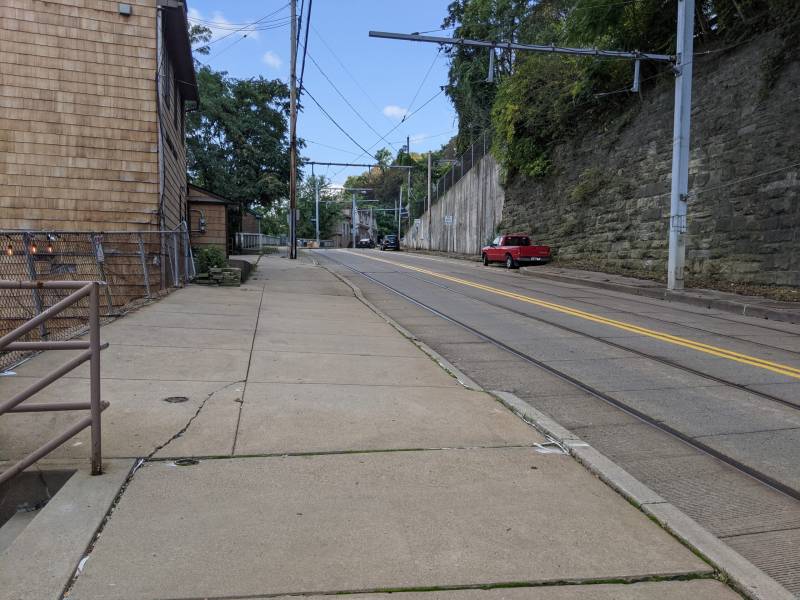 27. Arlington Ave.
27. Arlington Ave.Make left and ascend Arlington two blocks. Pass Behring St. and round the corner where you’ll find Hartford St. The trolley tracks link Station Square below with Allentown, a hilltop community.
Make left and ascend Arlington two blocks. Pass Behring St. and round the corner where you’ll find Hartford St. The trolley tracks link Station Square below with Allentown, a hilltop community.
Make left and ascend Arlington two blocks. Pass Behring St. and round the corner where you’ll find Hartford St. The trolley tracks link Station Square below with Allentown, a hilltop community.
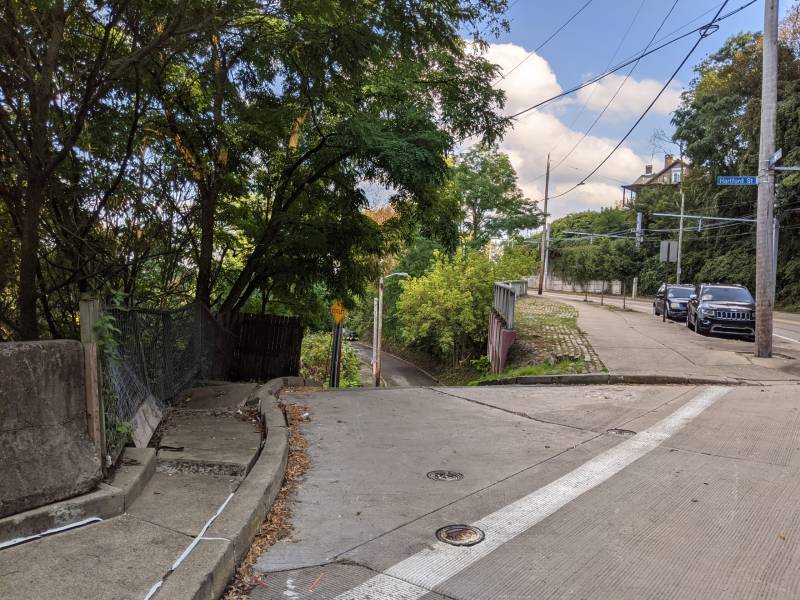 28. Hartford St.
28. Hartford St.Take a left and descend the narrow, curvy lane. Stay right and descend 27 steps. Continue to end of street and steps. That’s St. Paul of the Cross Monastery high on the hill across the ravine.
Take a left and descend the narrow, curvy lane. Stay right and descend 27 steps. Continue to end of street and steps. That’s St. Paul of the Cross Monastery high on the hill across the ravine.
Take a left and descend the narrow, curvy lane. Stay right and descend 27 steps. Continue to end of street and steps. That’s St. Paul of the Cross Monastery high on the hill across the ravine.
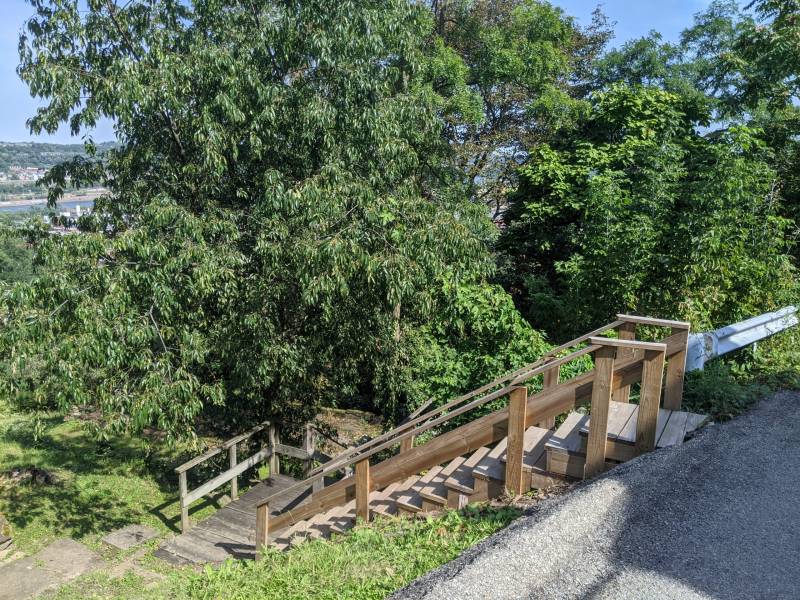 29. Hartford St. Steps
29. Hartford St. StepsMake left and descend 70 wooden steps to Fritz St.
Make left and descend 70 wooden steps to Fritz St.
Make left and descend 70 wooden steps to Fritz St.
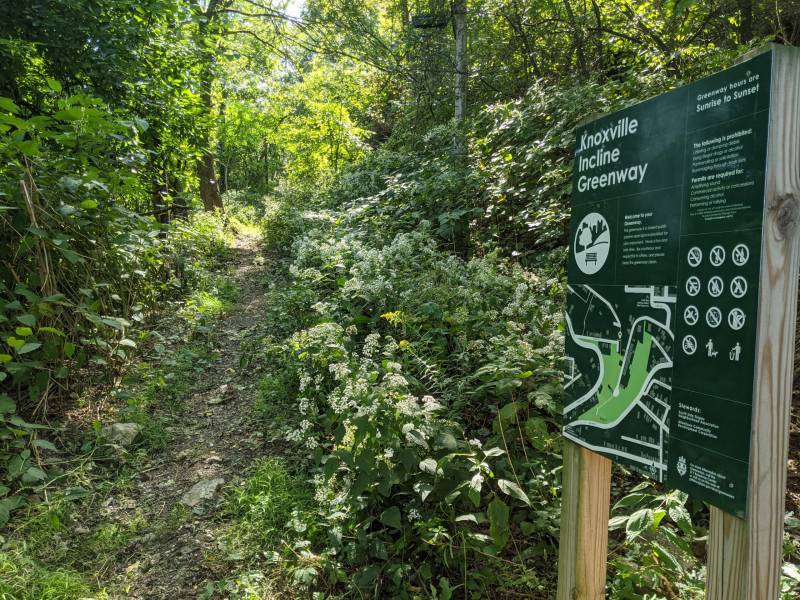 30. Fritz St. & Knoxville Incline Trail
30. Fritz St. & Knoxville Incline TrailTurn right. The trail follows what was Fritz St. It’s hard to believe you’re in the city! Be careful as you walk Knoxville Incline Trail to Brosville St.
Turn right. The trail follows what was Fritz St. It’s hard to believe you’re in the city! Be careful as you walk Knoxville Incline Trail to Brosville St.
Turn right. The trail follows what was Fritz St. It’s hard to believe you’re in the city! Be careful as you walk Knoxville Incline Trail to Brosville St.
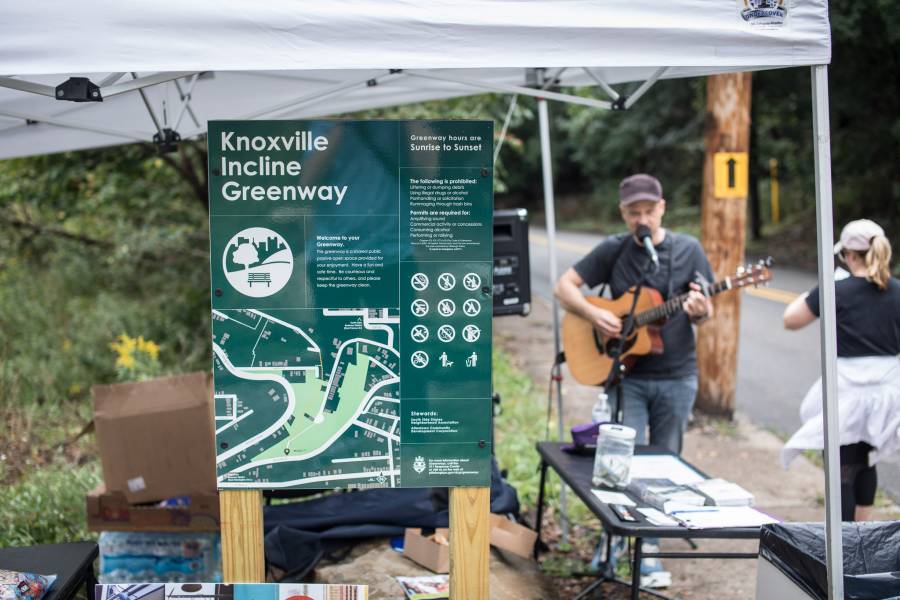 31. * The Knoxville Incline Greenway
31. * The Knoxville Incline GreenwayA gravel, timber-lined foot trail marks the entrance from Brosville. A bridge crosses over where the Knoxville Incline ran from 1890 to 1960. Over the years, SSSNA members have pulled several hundred tires from the ravine as part of an area clean up. Now a parklet honors its history. From the right side of bridge you can see heavy stone retaining walls and the trough through which the incline rode. The Greenway was created in 2016 in partnership with GTECH Strategies as part of its ReClaim South program. It continues down the Welsh Way stairs. The project is on the border with Allentown and Allentown CDC donated the trees planted in the parklet.
A gravel, timber-lined foot trail marks the entrance from Brosville. A bridge crosses over where the Knoxville Incline ran from 1890 to 1960. Over the years, SSSNA members have pulled several hundred tires from the ravine as part of an area clean up. Now a parklet honors its history. From the right side of bridge you can see heavy stone retaining walls and the trough through which the incline rode. The Greenway was created in 2016 in partnership with GTECH Strategies as part of its ReClaim South program. It continues down the Welsh Way stairs. The project is on the border with Allentown and Allentown CDC donated the trees planted in the parklet.
A gravel, timber-lined foot trail marks the entrance from Brosville. A bridge crosses over where the Knoxville Incline ran from 1890 to 1960. Over the years, SSSNA members have pulled several hundred tires from the ravine as part of an area clean up. Now a parklet honors its history. From the right side of bridge you can see heavy stone retaining walls and the trough through which the incline rode. The Greenway was created in 2016 in partnership with GTECH Strategies as part of its ReClaim South program. It continues down the Welsh Way stairs. The project is on the border with Allentown and Allentown CDC donated the trees planted in the parklet.
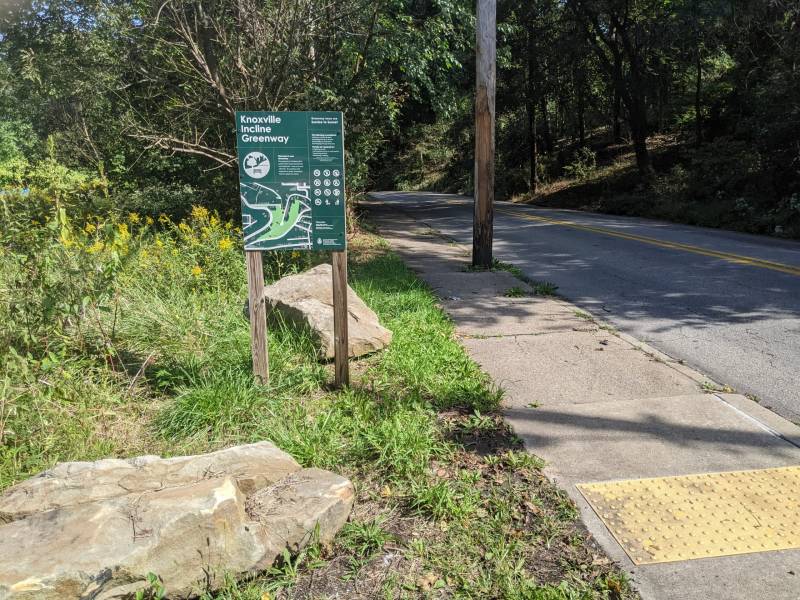 32. Brosville St.
32. Brosville St.Take a left and keep left as you descend Brosville. That’s Allentown up hill to the right. Walk down Brosville a few hundred yards to Welcome Garden at Monastery St.
Take a left and keep left as you descend Brosville. That’s Allentown up hill to the right. Walk down Brosville a few hundred yards to Welcome Garden at Monastery St.
Take a left and keep left as you descend Brosville. That’s Allentown up hill to the right. Walk down Brosville a few hundred yards to Welcome Garden at Monastery St.
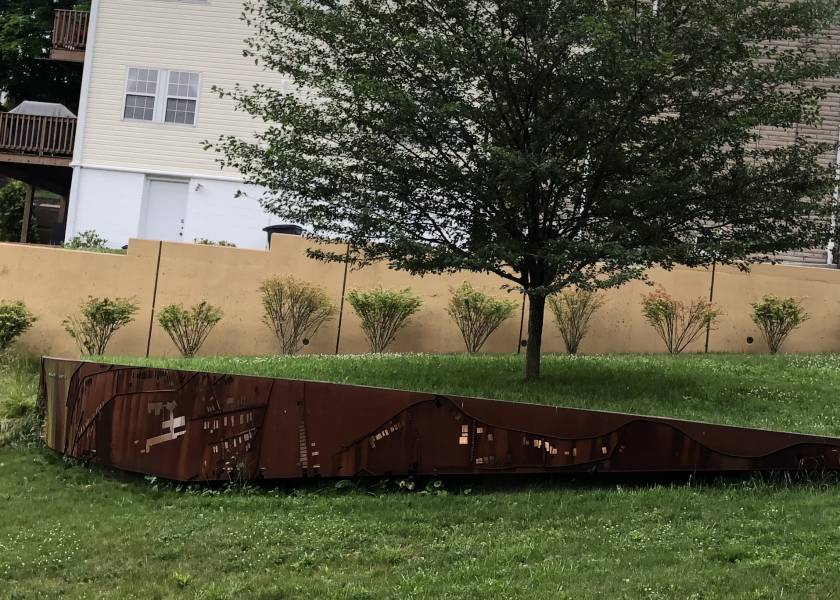 33. * Brosville-Monastery Welcome Garden
33. * Brosville-Monastery Welcome GardenTerraced into the hillside on the right is a quiet green space. The fabricated canvas of COR-TEN steel plate was created by former SSSNA board member and architect Peter Kreuthmeier and installed against a curved retaining wall. The scrim replicates a section of a Slopes neighborhood from a lot and block map. An Elm Street project funded by the state, it was dedicated in 2007 and is one of six gardens maintained by SSSNA members. The installation has garnered both state and local awards.
Terraced into the hillside on the right is a quiet green space. The fabricated canvas of COR-TEN steel plate was created by former SSSNA board member and architect Peter Kreuthmeier and installed against a curved retaining wall. The scrim replicates a section of a Slopes neighborhood from a lot and block map. An Elm Street project funded by the state, it was dedicated in 2007 and is one of six gardens maintained by SSSNA members. The installation has garnered both state and local awards.
Terraced into the hillside on the right is a quiet green space. The fabricated canvas of COR-TEN steel plate was created by former SSSNA board member and architect Peter Kreuthmeier and installed against a curved retaining wall. The scrim replicates a section of a Slopes neighborhood from a lot and block map. An Elm Street project funded by the state, it was dedicated in 2007 and is one of six gardens maintained by SSSNA members. The installation has garnered both state and local awards.
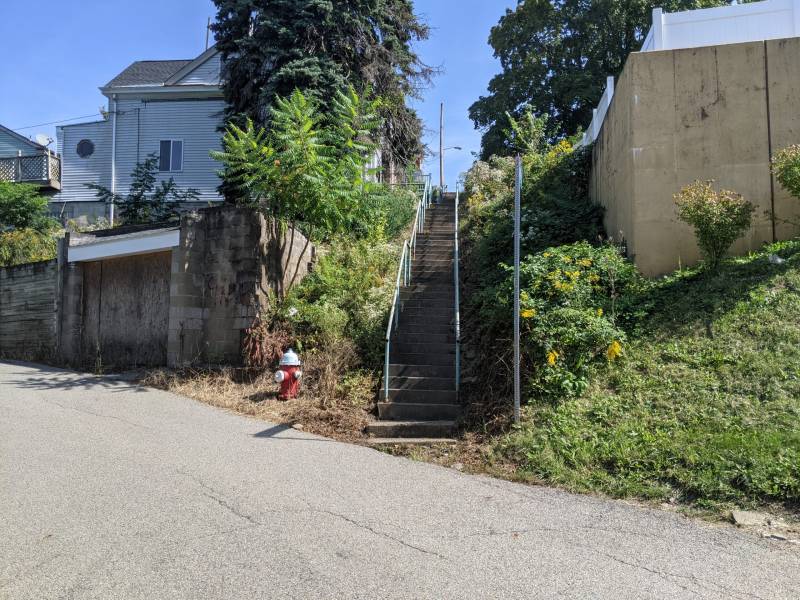 34. Hackstown St. & St. Joseph Way Steps
34. Hackstown St. & St. Joseph Way StepsBe careful as you cross Brosville to Hackstown St. Directly ahead are St. Joseph Way Steps. Ascend the 76 steps to St. Joseph Way. Note that the first few houses have access via the steps only. Ascend the 76 steps to St. Joseph Way. Note that the first few houses have access via the steps only.
Be careful as you cross Brosville to Hackstown St. Directly ahead are St. Joseph Way Steps. Ascend the 76 steps to St. Joseph Way. Note that the first few houses have access via the steps only. Ascend the 76 steps to St. Joseph Way. Note that the first few houses have access via the steps only.
Be careful as you cross Brosville to Hackstown St. Directly ahead are St. Joseph Way Steps. Ascend the 76 steps to St. Joseph Way. Note that the first few houses have access via the steps only. Ascend the 76 steps to St. Joseph Way. Note that the first few houses have access via the steps only.
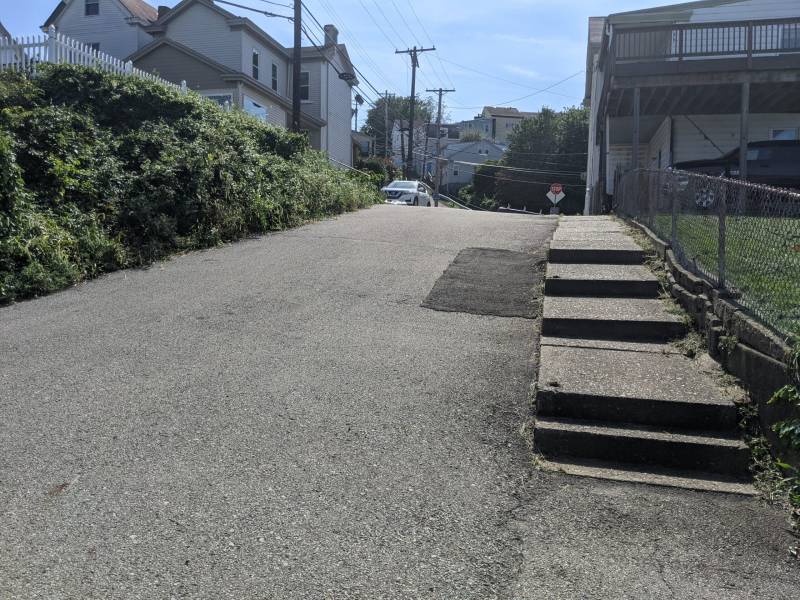 35. St. Thomas St.
35. St. Thomas St.Make right and climb 5 steps on the way to Monastery St.
Make right and climb 5 steps on the way to Monastery St.
Make right and climb 5 steps on the way to Monastery St.
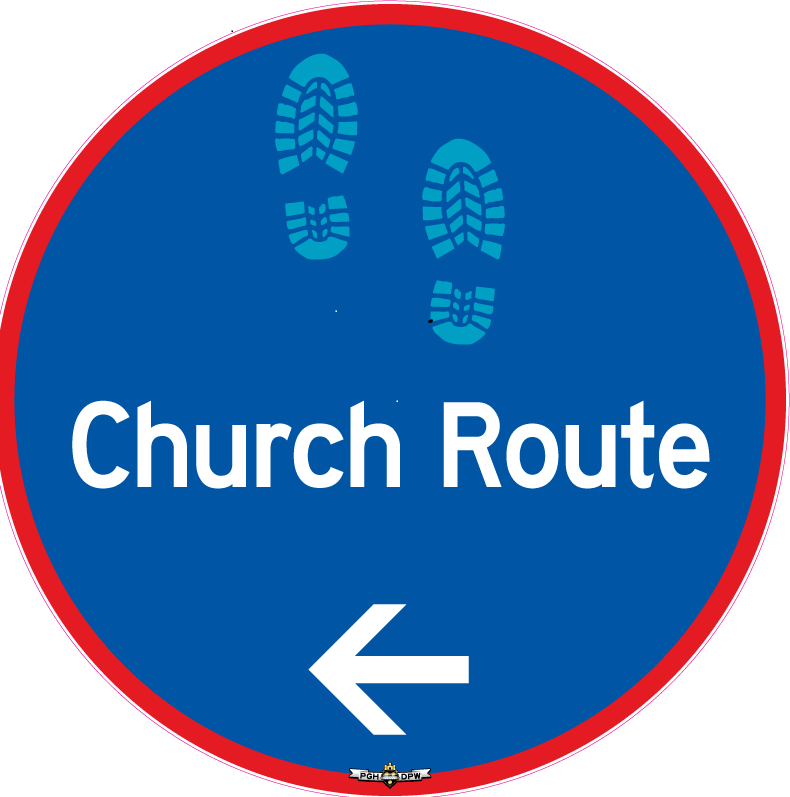 36. * Church Route
36. * Church RouteYou are now following part of the Church Route. The Church Route is a walking tour that goes up and down our unique stairways providing beautiful views of the city, and featuring glimpses of the eccentric hillside architecture and historic churches. For 10 years this route was a part of the SSSNA’s annual StepTrek but the association decided to formalize the route into a permanently signed walk instead. Funding for the signage was provided by the SSSNA in partnership with the City of Pittsburgh, who manufactured and installed the wayfinding signs.
You are now following part of the Church Route. The Church Route is a walking tour that goes up and down our unique stairways providing beautiful views of the city, and featuring glimpses of the eccentric hillside architecture and historic churches. For 10 years this route was a part of the SSSNA’s annual StepTrek but the association decided to formalize the route into a permanently signed walk instead. Funding for the signage was provided by the SSSNA in partnership with the City of Pittsburgh, who manufactured and installed the wayfinding signs.
You are now following part of the Church Route. The Church Route is a walking tour that goes up and down our unique stairways providing beautiful views of the city, and featuring glimpses of the eccentric hillside architecture and historic churches. For 10 years this route was a part of the SSSNA’s annual StepTrek but the association decided to formalize the route into a permanently signed walk instead. Funding for the signage was provided by the SSSNA in partnership with the City of Pittsburgh, who manufactured and installed the wayfinding signs.
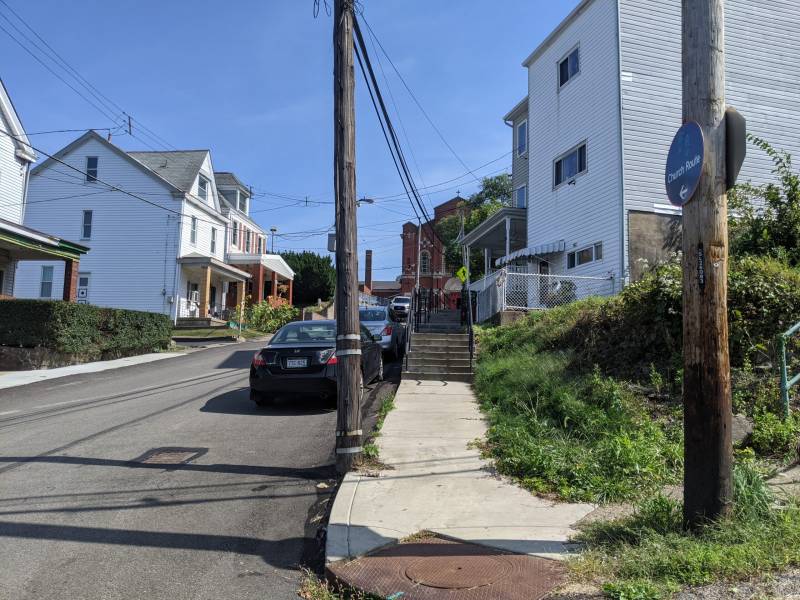 37. Monastery St. Steps
37. Monastery St. StepsCross street and make left to ascend 15 steps on the right side. These steps and sidewalk were rebuilt a few years ago as part of a project to replace a larger set of steps that ran the length of Monastery. At the top lies the historical St. Paul of the Cross Monastery.
Cross street and make left to ascend 15 steps on the right side. These steps and sidewalk were rebuilt a few years ago as part of a project to replace a larger set of steps that ran the length of Monastery. At the top lies the historical St. Paul of the Cross Monastery.
Cross street and make left to ascend 15 steps on the right side. These steps and sidewalk were rebuilt a few years ago as part of a project to replace a larger set of steps that ran the length of Monastery. At the top lies the historical St. Paul of the Cross Monastery.
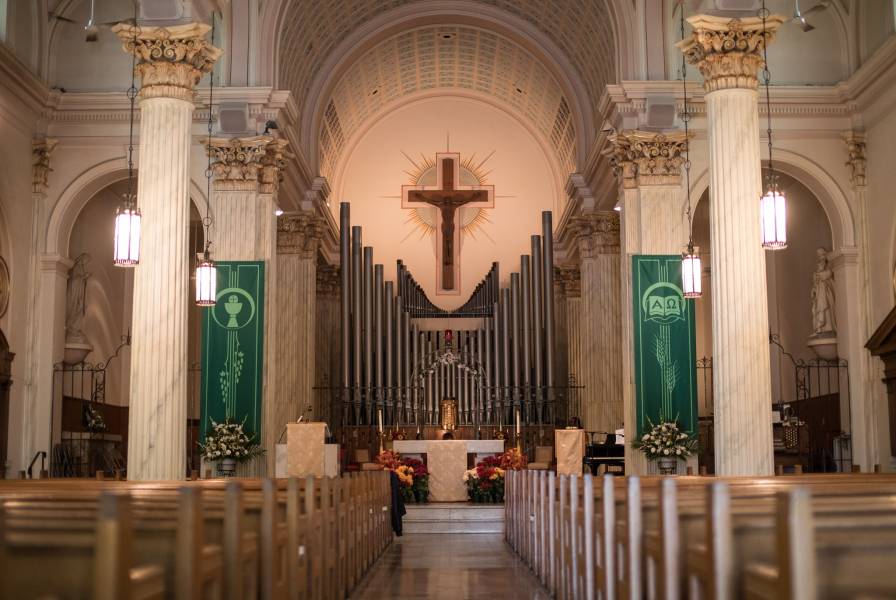 38. * St. Paul of the Cross Monastery
38. * St. Paul of the Cross MonasteryKnown as the barefoot missionaries, the Passionists vowed to live a life of prayer, poverty, penance and solitude. The first bishop of Pittsburgh invited the Italian order over in 1852. Designed by the architect Charles Bartberger, who also designed St. Michael Church, the church was completed in 1859 in the midst of an 11 acre compound chosen for its serenity, natural beauty and seclusion. The architectural style is Romanesque. The interior rose window is a copy of one in Reims, Germany. The newly renovated chapel is exquisite and opens daily from 7 a.m. to 5 p.m. Please step inside for quiet observation. On exiting the chapel, take in the stunning view of downtown.
Known as the barefoot missionaries, the Passionists vowed to live a life of prayer, poverty, penance and solitude. The first bishop of Pittsburgh invited the Italian order over in 1852. Designed by the architect Charles Bartberger, who also designed St. Michael Church, the church was completed in 1859 in the midst of an 11 acre compound chosen for its serenity, natural beauty and seclusion. The architectural style is Romanesque. The interior rose window is a copy of one in Reims, Germany. The newly renovated chapel is exquisite and opens daily from 7 a.m. to 5 p.m. Please step inside for quiet observation. On exiting the chapel, take in the stunning view of downtown.
Known as the barefoot missionaries, the Passionists vowed to live a life of prayer, poverty, penance and solitude. The first bishop of Pittsburgh invited the Italian order over in 1852. Designed by the architect Charles Bartberger, who also designed St. Michael Church, the church was completed in 1859 in the midst of an 11 acre compound chosen for its serenity, natural beauty and seclusion. The architectural style is Romanesque. The interior rose window is a copy of one in Reims, Germany. The newly renovated chapel is exquisite and opens daily from 7 a.m. to 5 p.m. Please step inside for quiet observation. On exiting the chapel, take in the stunning view of downtown.
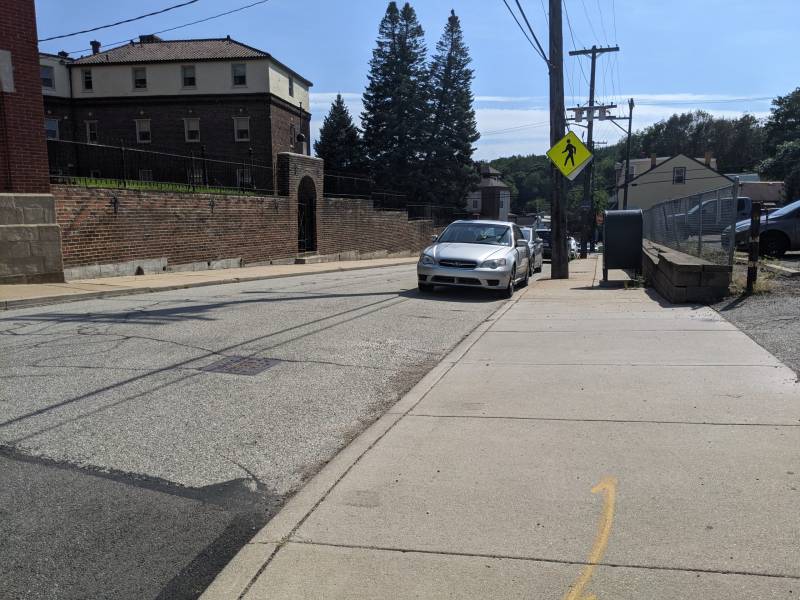 39. Monastery Ave.
39. Monastery Ave.From the top of Monastery St., make a right and descend along right side of Monastery Ave. to S. 18th St.
From the top of Monastery St., make a right and descend along right side of Monastery Ave. to S. 18th St.
From the top of Monastery St., make a right and descend along right side of Monastery Ave. to S. 18th St.
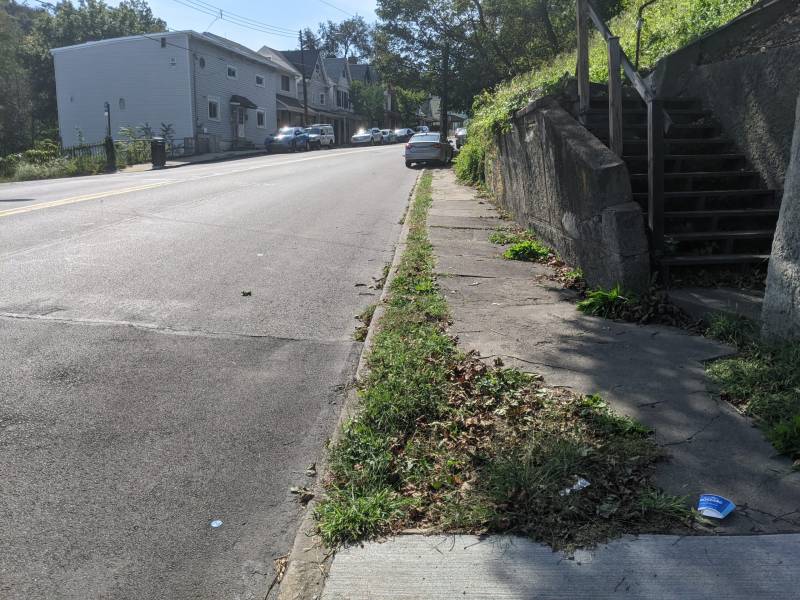 40. S. 18th St.
40. S. 18th St.Take a right and walk up S. 18th to St. Thomas St. Steps. Quarry St. is on the left, across from entrance to the steps.
Take a right and walk up S. 18th to St. Thomas St. Steps. Quarry St. is on the left, across from entrance to the steps.
Take a right and walk up S. 18th to St. Thomas St. Steps. Quarry St. is on the left, across from entrance to the steps.
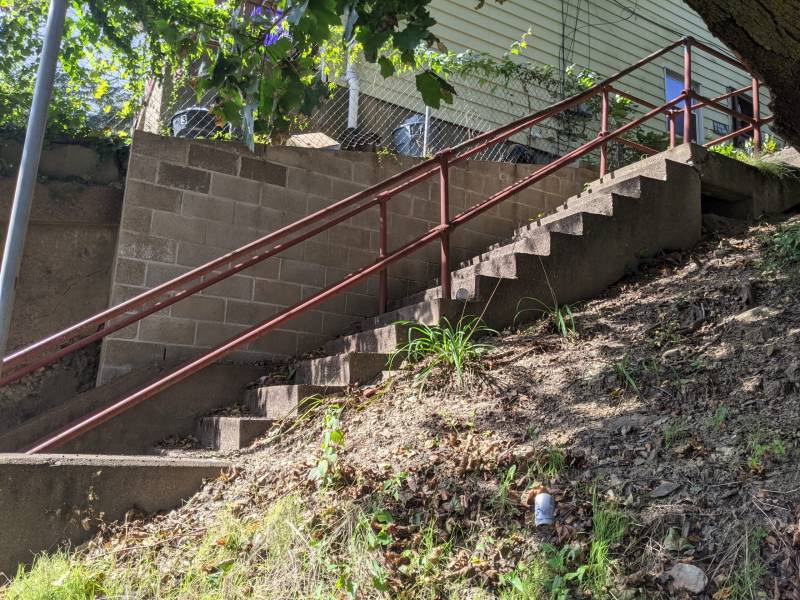 41. St. Thomas St. Steps
41. St. Thomas St. StepsMake right and climb 44 steps and turn right at landing. Follow the red railing and drop two steps. Make a left and climb sidewalk that leads to St. Thomas St. Continue up 4 steps in sidewalk to Angelo St.
Make right and climb 44 steps and turn right at landing. Follow the red railing and drop two steps. Make a left and climb sidewalk that leads to St. Thomas St. Continue up 4 steps in sidewalk to Angelo St.
Make right and climb 44 steps and turn right at landing. Follow the red railing and drop two steps. Make a left and climb sidewalk that leads to St. Thomas St. Continue up 4 steps in sidewalk to Angelo St.
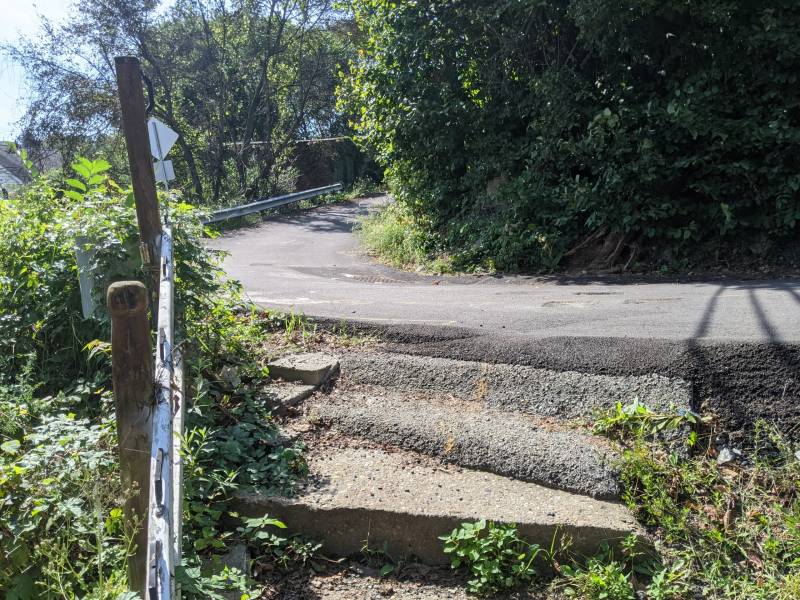 42. Angelo St.
42. Angelo St.Take left and climb 5 steps. Keep left and continue past Wachter St. with its view of St. Michael Cemetery on the hill to the left. At next street, make left onto Rugraff St.
Take left and climb 5 steps. Keep left and continue past Wachter St. with its view of St. Michael Cemetery on the hill to the left. At next street, make left onto Rugraff St.
Take left and climb 5 steps. Keep left and continue past Wachter St. with its view of St. Michael Cemetery on the hill to the left. At next street, make left onto Rugraff St.
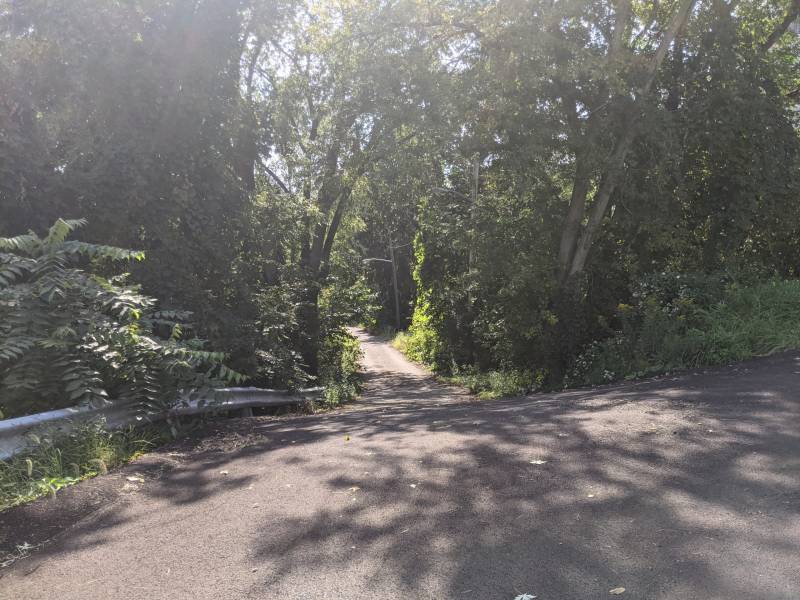 43. Rugraff St.
43. Rugraff St.The Slopes neighborhood possesses quiet, sometimes forgotten, alleys that provide respite and seclusion from the city. Rugraff provides views to the left of wooded hillsides and distant houses. To the right, perched over the slopes, rise tall, tightly packed houses. Continue to 18th St. and the colorful, hillside mural.
The Slopes neighborhood possesses quiet, sometimes forgotten, alleys that provide respite and seclusion from the city. Rugraff provides views to the left of wooded hillsides and distant houses. To the right, perched over the slopes, rise tall, tightly packed houses. Continue to 18th St. and the colorful, hillside mural.
The Slopes neighborhood possesses quiet, sometimes forgotten, alleys that provide respite and seclusion from the city. Rugraff provides views to the left of wooded hillsides and distant houses. To the right, perched over the slopes, rise tall, tightly packed houses. Continue to 18th St. and the colorful, hillside mural.
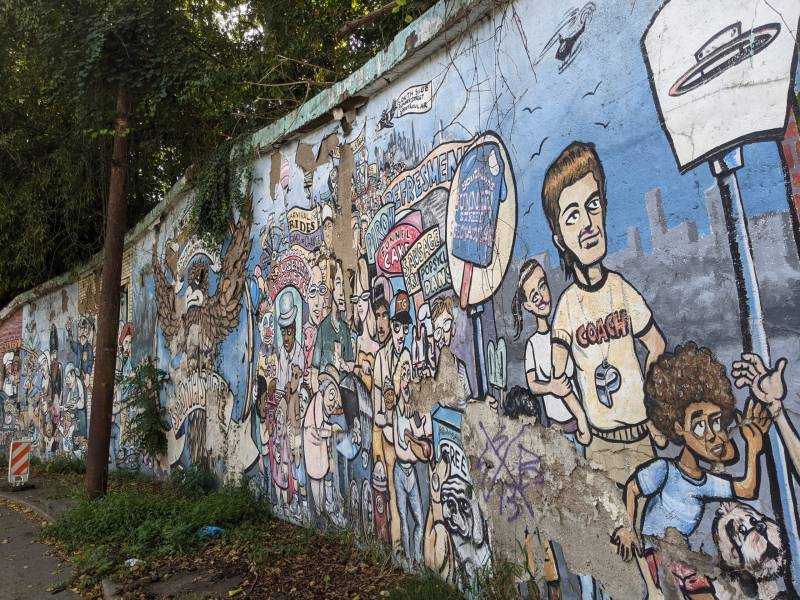 44. * Mural on S. 18th Street
44. * Mural on S. 18th StreetNearly everyone on the Slopes has a retaining wall. They are a function of the steep terrain and the residents’ desire to make the most use of their land. A state grant in 2004 turned this retaining wall into a work of art. Unfortunately, seeping water has taken its toll on the mural. Its timeline starts in the 1850s when South Side existed as a separate town called Birmingham. Created by Richard Bach, the mural depicts the varied character of South Side, its love of music and athletics, hard-work and fun.
Nearly everyone on the Slopes has a retaining wall. They are a function of the steep terrain and the residents’ desire to make the most use of their land. A state grant in 2004 turned this retaining wall into a work of art. Unfortunately, seeping water has taken its toll on the mural. Its timeline starts in the 1850s when South Side existed as a separate town called Birmingham. Created by Richard Bach, the mural depicts the varied character of South Side, its love of music and athletics, hard-work and fun.
Nearly everyone on the Slopes has a retaining wall. They are a function of the steep terrain and the residents’ desire to make the most use of their land. A state grant in 2004 turned this retaining wall into a work of art. Unfortunately, seeping water has taken its toll on the mural. Its timeline starts in the 1850s when South Side existed as a separate town called Birmingham. Created by Richard Bach, the mural depicts the varied character of South Side, its love of music and athletics, hard-work and fun.
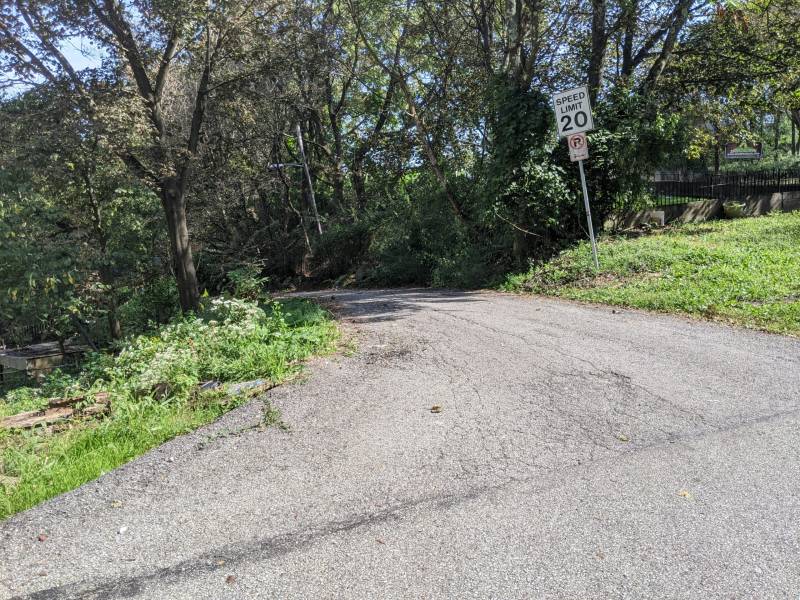 45. Quarry St.
45. Quarry St.Be careful as you cross S. 18th St. to Quarry St. Walk this quirky lane that starts at the top of a vale that descends through the Slopes. Continue along Quarry to where it ends at steps.
Be careful as you cross S. 18th St. to Quarry St. Walk this quirky lane that starts at the top of a vale that descends through the Slopes. Continue along Quarry to where it ends at steps.
Be careful as you cross S. 18th St. to Quarry St. Walk this quirky lane that starts at the top of a vale that descends through the Slopes. Continue along Quarry to where it ends at steps.
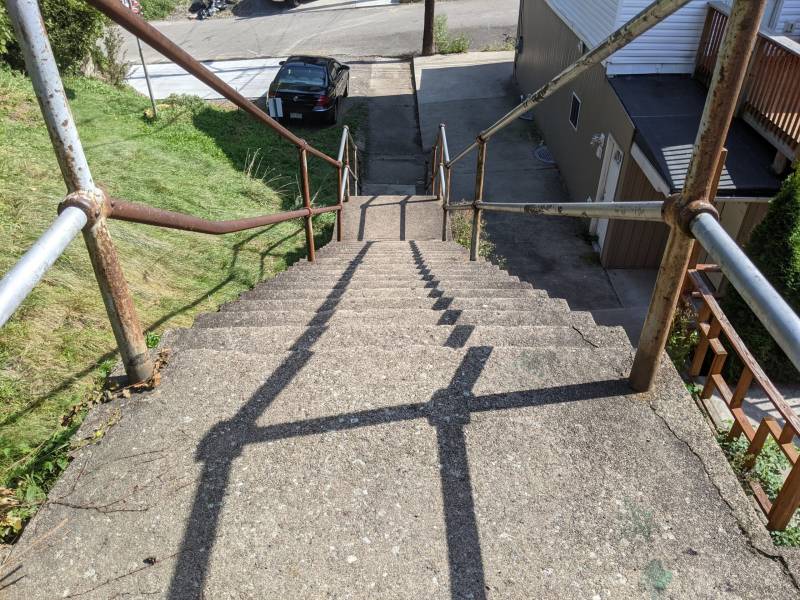 46. Quarry St. Steps
46. Quarry St. StepsAt street’s end, turn right and descend 32 steps.
At street’s end, turn right and descend 32 steps.
At street’s end, turn right and descend 32 steps.
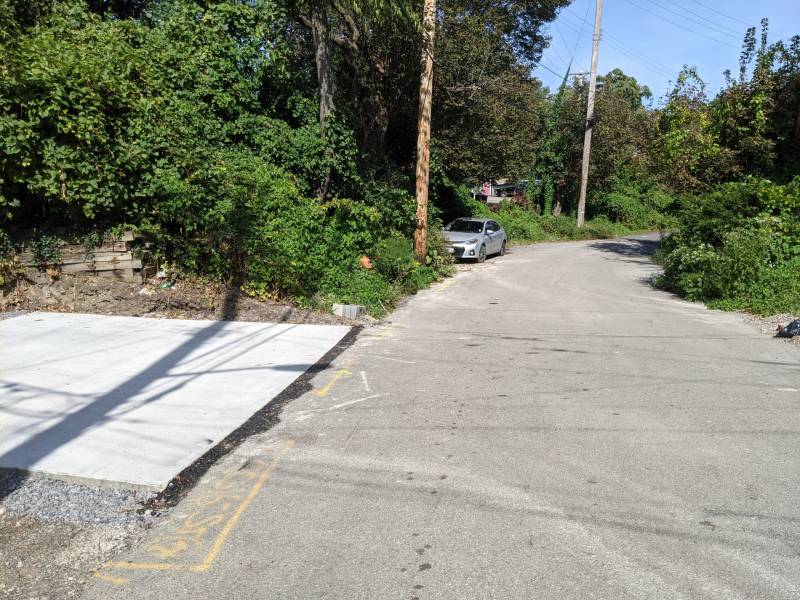 47. Lower Quarry St.
47. Lower Quarry St.At the bottom of the steps turn left, where you again pick up Quarry St. Continue walking forward and keep right to join Gable St. Keeping right, follow to its end at St. Patrick St.
At the bottom of the steps turn left, where you again pick up Quarry St. Continue walking forward and keep right to join Gable St. Keeping right, follow to its end at St. Patrick St.
At the bottom of the steps turn left, where you again pick up Quarry St. Continue walking forward and keep right to join Gable St. Keeping right, follow to its end at St. Patrick St.
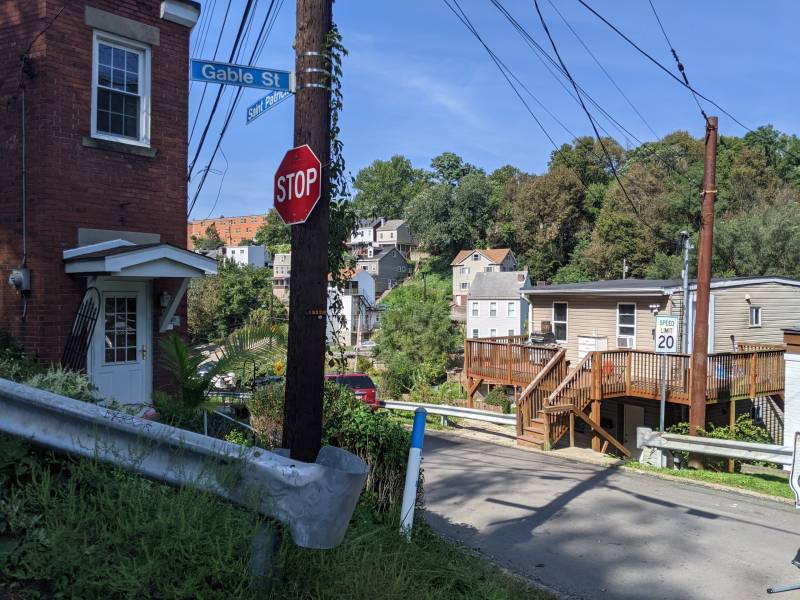 48. St. Patrick St.
48. St. Patrick St.Make left and descend St. Patrick. Continue past Saber Way and ascend toward S. 18th St. Take the last five steps on left to S. 18th St.
Make left and descend St. Patrick. Continue past Saber Way and ascend toward S. 18th St. Take the last five steps on left to S. 18th St.
Make left and descend St. Patrick. Continue past Saber Way and ascend toward S. 18th St. Take the last five steps on left to S. 18th St.
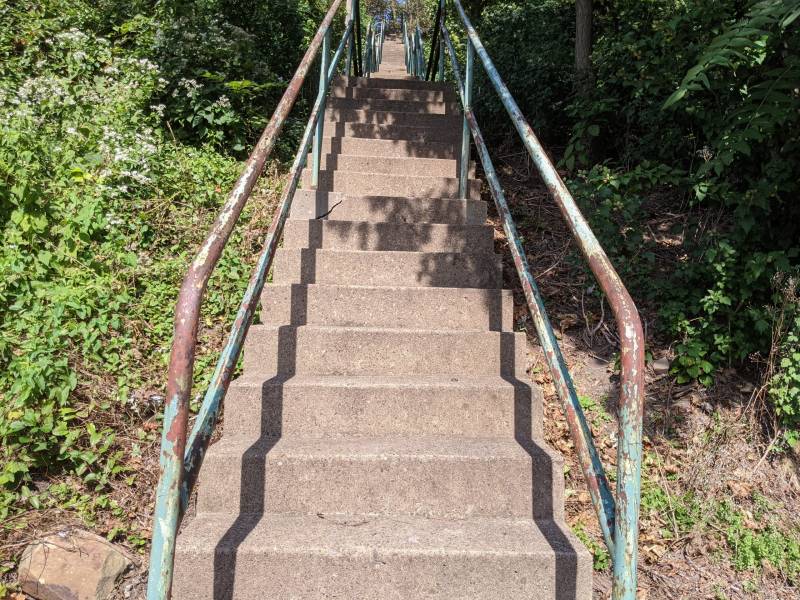 49. St. Paul St. Steps
49. St. Paul St. StepsUse caution in crossing S. 18th Street to steps on opposite side. Ascend the 82 steps to St. Paul St.
Use caution in crossing S. 18th Street to steps on opposite side. Ascend the 82 steps to St. Paul St.
Use caution in crossing S. 18th Street to steps on opposite side. Ascend the 82 steps to St. Paul St.
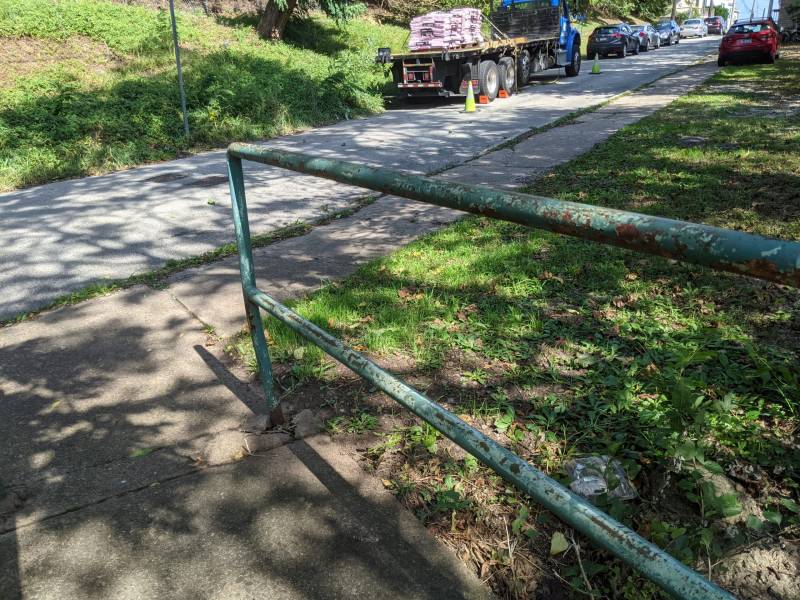 50. St. Paul St.
50. St. Paul St.At top of steps, notice the brick garden wall to the far left. It is part of the St. Paul of the Cross Monastery and Retreat Center. The wall appear to be the original one that shielded the enclave from the outside world. The garden features the Stations of the Cross which can be seen through the metal fencing opposite the steps. Turn right. Follow St. Paul to Yard Way. Welcome to Billy Buck Hill!
At top of steps, notice the brick garden wall to the far left. It is part of the St. Paul of the Cross Monastery and Retreat Center. The wall appear to be the original one that shielded the enclave from the outside world. The garden features the Stations of the Cross which can be seen through the metal fencing opposite the steps. Turn right. Follow St. Paul to Yard Way. Welcome to Billy Buck Hill!
At top of steps, notice the brick garden wall to the far left. It is part of the St. Paul of the Cross Monastery and Retreat Center. The wall appear to be the original one that shielded the enclave from the outside world. The garden features the Stations of the Cross which can be seen through the metal fencing opposite the steps. Turn right. Follow St. Paul to Yard Way. Welcome to Billy Buck Hill!
 51. * Billy Buck Hill
51. * Billy Buck HillFounded by Germans, its homes – like many on the South Side – have passed through generations of families. The name Billy Buck comes from goats once kept in the yard of a local store. Bordered by cliffs and rugged terrain, the area is accessible by steps and a single street. According to the Post-Gazette, there have been a couple of famous mishaps here. Once a milk truck flipped over while making deliveries on its hilly streets. Another time, a horse and wagon, hauling waste from neighborhood outhouses, tumbled over the hillside.
Founded by Germans, its homes – like many on the South Side – have passed through generations of families. The name Billy Buck comes from goats once kept in the yard of a local store. Bordered by cliffs and rugged terrain, the area is accessible by steps and a single street. According to the Post-Gazette, there have been a couple of famous mishaps here. Once a milk truck flipped over while making deliveries on its hilly streets. Another time, a horse and wagon, hauling waste from neighborhood outhouses, tumbled over the hillside.
Founded by Germans, its homes – like many on the South Side – have passed through generations of families. The name Billy Buck comes from goats once kept in the yard of a local store. Bordered by cliffs and rugged terrain, the area is accessible by steps and a single street. According to the Post-Gazette, there have been a couple of famous mishaps here. Once a milk truck flipped over while making deliveries on its hilly streets. Another time, a horse and wagon, hauling waste from neighborhood outhouses, tumbled over the hillside.
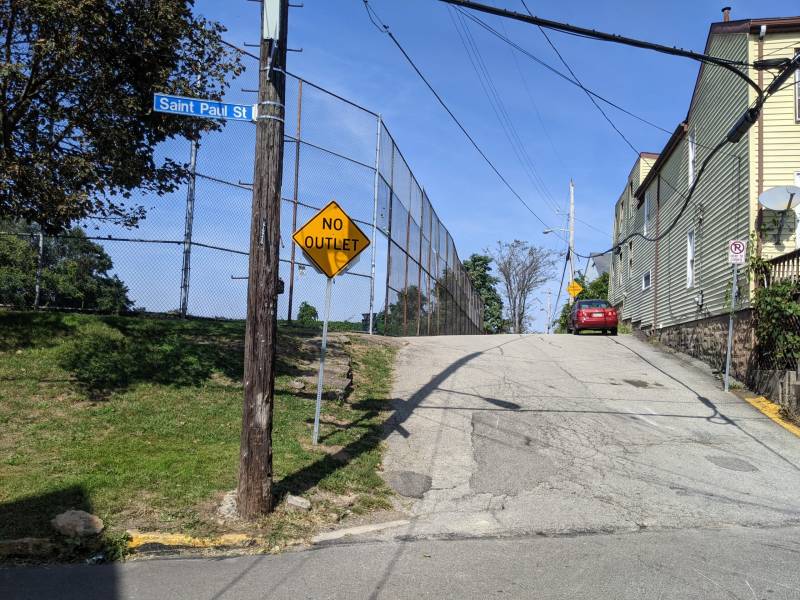 52. Yard Way
52. Yard WayMake a left on Yard Way and walk to Shamokin St. View uptown, Oakland and Greenfield across the river. South Side Works, on the site of the former LTV site, sits to the bottom right.
Make a left on Yard Way and walk to Shamokin St. View uptown, Oakland and Greenfield across the river. South Side Works, on the site of the former LTV site, sits to the bottom right.
Make a left on Yard Way and walk to Shamokin St. View uptown, Oakland and Greenfield across the river. South Side Works, on the site of the former LTV site, sits to the bottom right.
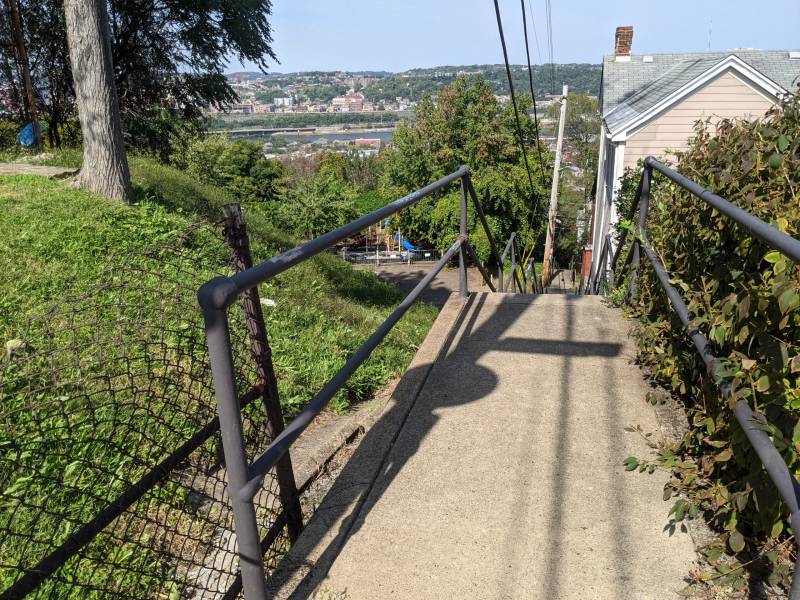 53. The Yard Way Steps
53. The Yard Way StepsBuilt in 1944, the steps drop a total of 301 stairs to Pius St. below. Cross Shamokin and descend 63 of them to Huron St. and the temporarily closed Winters Playground. It is one of a series of parklets dotting the hillside. If you complete both routes, you will pass three of them.
Built in 1944, the steps drop a total of 301 stairs to Pius St. below. Cross Shamokin and descend 63 of them to Huron St. and the temporarily closed Winters Playground. It is one of a series of parklets dotting the hillside. If you complete both routes, you will pass three of them.
Built in 1944, the steps drop a total of 301 stairs to Pius St. below. Cross Shamokin and descend 63 of them to Huron St. and the temporarily closed Winters Playground. It is one of a series of parklets dotting the hillside. If you complete both routes, you will pass three of them.
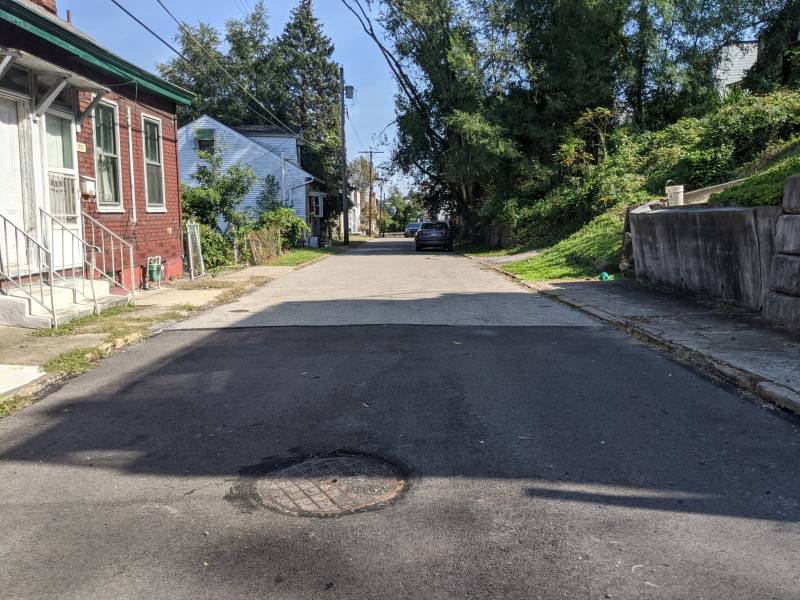 54. Huron St.
54. Huron St.Make right. This dead-end street is pitched high in the Slopes with lovely view below.
Make right. This dead-end street is pitched high in the Slopes with lovely view below.
Make right. This dead-end street is pitched high in the Slopes with lovely view below.
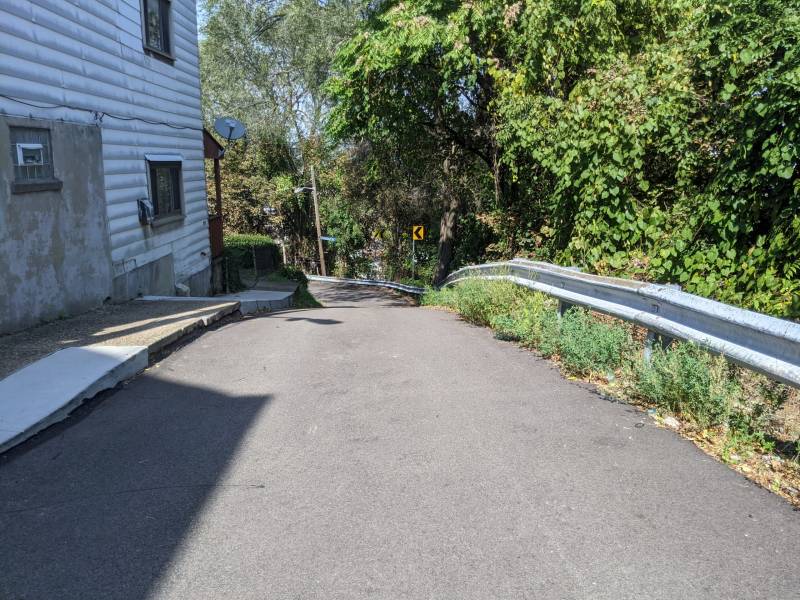 55. Oporto St.
55. Oporto St.Make left and descend to Oporto St. Steps. A landslide this past spring has closed Oporto to the south and right of you. The neighborhood is in a constant negotiation with the city to maintain the infrastructure of its hillside community.
Make left and descend to Oporto St. Steps. A landslide this past spring has closed Oporto to the south and right of you. The neighborhood is in a constant negotiation with the city to maintain the infrastructure of its hillside community.
Make left and descend to Oporto St. Steps. A landslide this past spring has closed Oporto to the south and right of you. The neighborhood is in a constant negotiation with the city to maintain the infrastructure of its hillside community.
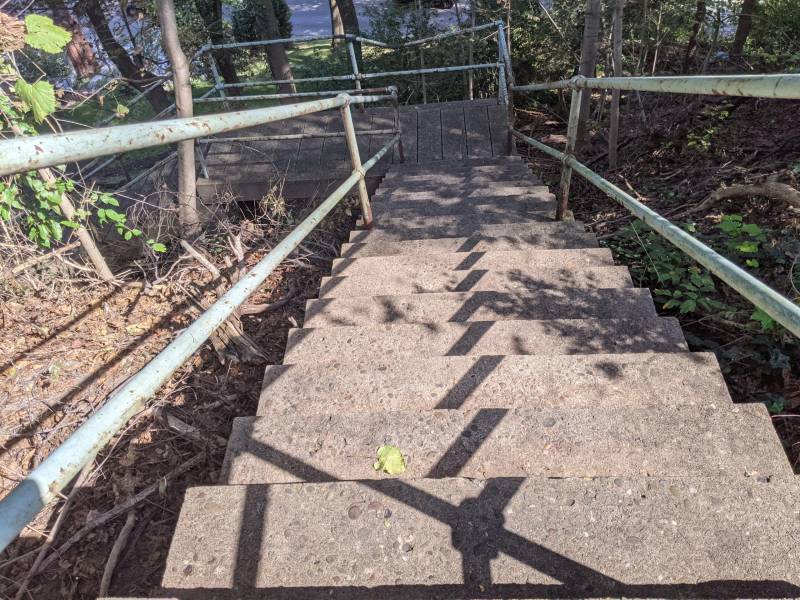 56. Oporto St. Steps
56. Oporto St. StepsDescend 10 steps and turn right. Begin descending the 115 steps to Roscoe St. To the right of the steps was the site of the Sankey brick yard that was active in the Slopes until the 1950s. Many a yard in the slopes has a stash of Sankey bricks buried under the soil.
Descend 10 steps and turn right. Begin descending the 115 steps to Roscoe St. To the right of the steps was the site of the Sankey brick yard that was active in the Slopes until the 1950s. Many a yard in the slopes has a stash of Sankey bricks buried under the soil.
Descend 10 steps and turn right. Begin descending the 115 steps to Roscoe St. To the right of the steps was the site of the Sankey brick yard that was active in the Slopes until the 1950s. Many a yard in the slopes has a stash of Sankey bricks buried under the soil.
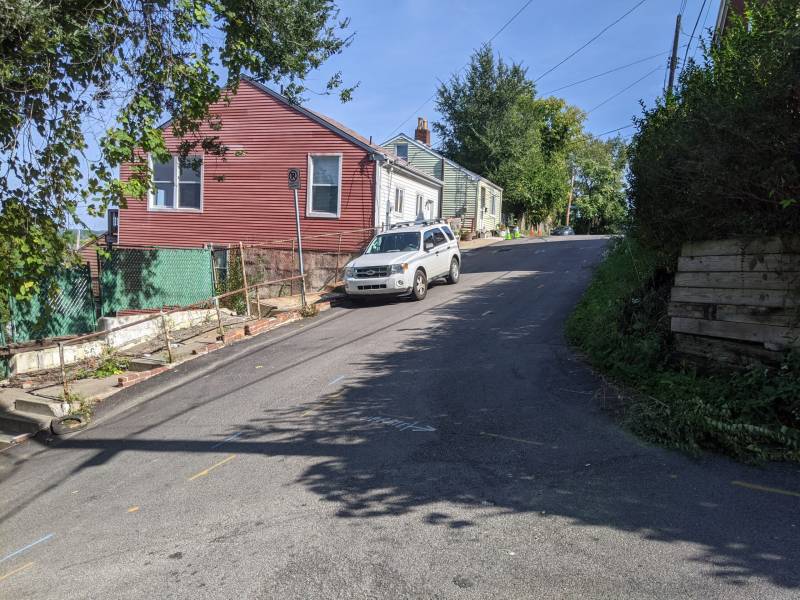 57. Roscoe St.
57. Roscoe St.At bottom of steps, cross lane and make right on Roscoe St. Ascend 8 steps on left side. Continue past Crossman St. to St. Leo St. Notice the tight yards on the right.
At bottom of steps, cross lane and make right on Roscoe St. Ascend 8 steps on left side. Continue past Crossman St. to St. Leo St. Notice the tight yards on the right.
At bottom of steps, cross lane and make right on Roscoe St. Ascend 8 steps on left side. Continue past Crossman St. to St. Leo St. Notice the tight yards on the right.
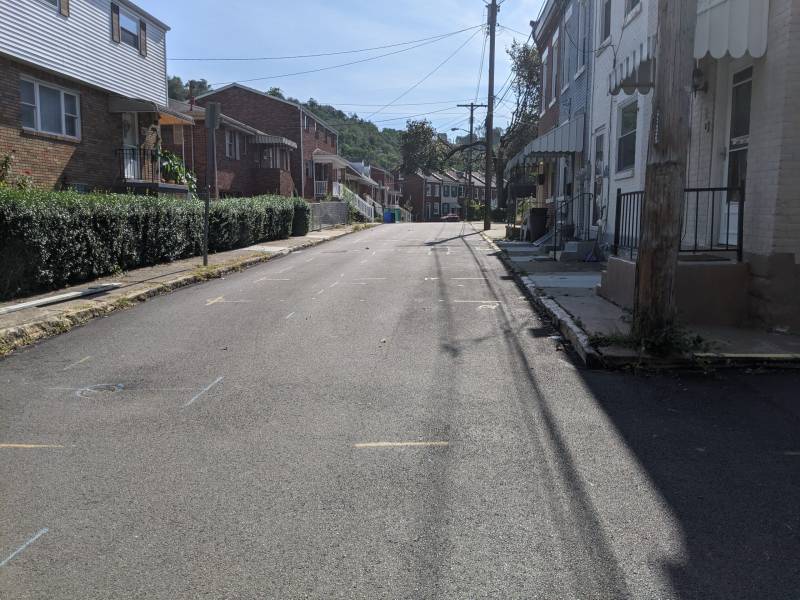 58. St. Leo St.
58. St. Leo St.Turn right and continue past century-old brick homes to where street meets Crossman St.
Turn right and continue past century-old brick homes to where street meets Crossman St.
Turn right and continue past century-old brick homes to where street meets Crossman St.
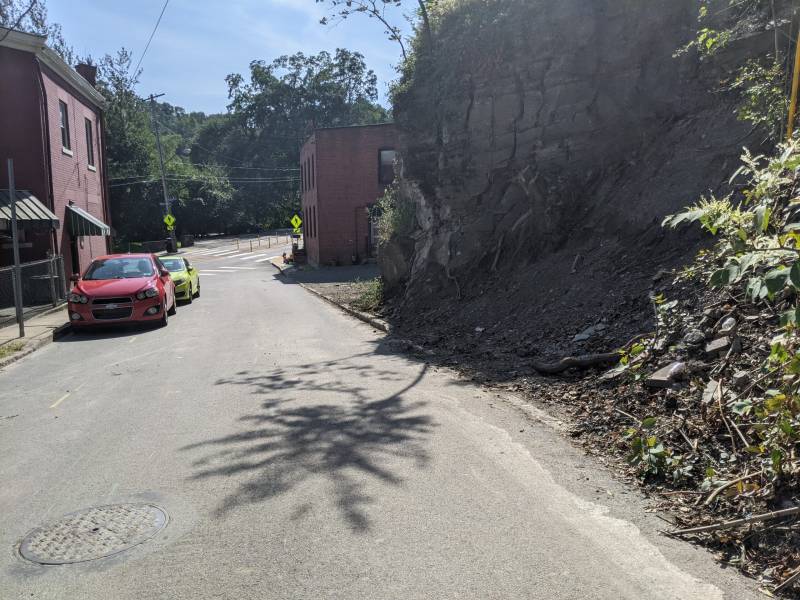 59. Crossman St.
59. Crossman St.Look up. You are now directly below the Oporto Street landslide. Make left and follow street to S. 18th St.
Look up. You are now directly below the Oporto Street landslide. Make left and follow street to S. 18th St.
Look up. You are now directly below the Oporto Street landslide. Make left and follow street to S. 18th St.
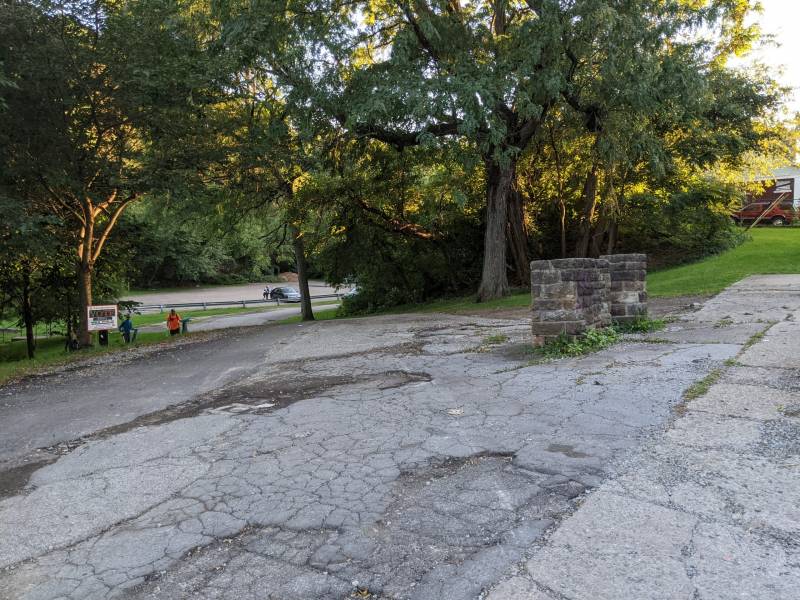 60. S. 18th St.
60. S. 18th St.Cross to opposite side and turn right. Walk 40 feet to entrance to South Side Park and walk down Kimbol St. into the park.
Cross to opposite side and turn right. Walk 40 feet to entrance to South Side Park and walk down Kimbol St. into the park.
Cross to opposite side and turn right. Walk 40 feet to entrance to South Side Park and walk down Kimbol St. into the park.
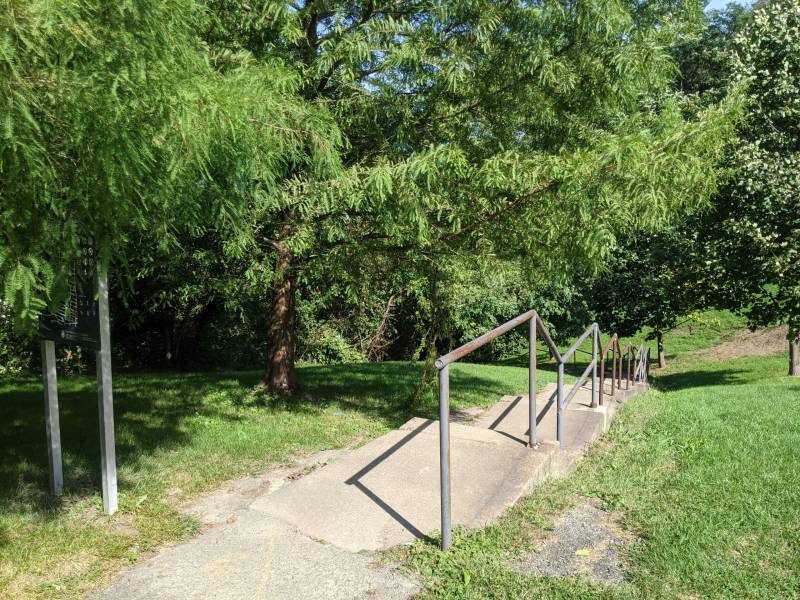 61. Serpentine Steps
61. Serpentine StepsMake a left and descend these 72 serpentine steps, grouped together in sets of three, to top of S. 21st St. Follow paved road on left down to the registration area where you started. The trees on the right were planted in 2013 by SSSNA.
Make a left and descend these 72 serpentine steps, grouped together in sets of three, to top of S. 21st St. Follow paved road on left down to the registration area where you started. The trees on the right were planted in 2013 by SSSNA.
Make a left and descend these 72 serpentine steps, grouped together in sets of three, to top of S. 21st St. Follow paved road on left down to the registration area where you started. The trees on the right were planted in 2013 by SSSNA.
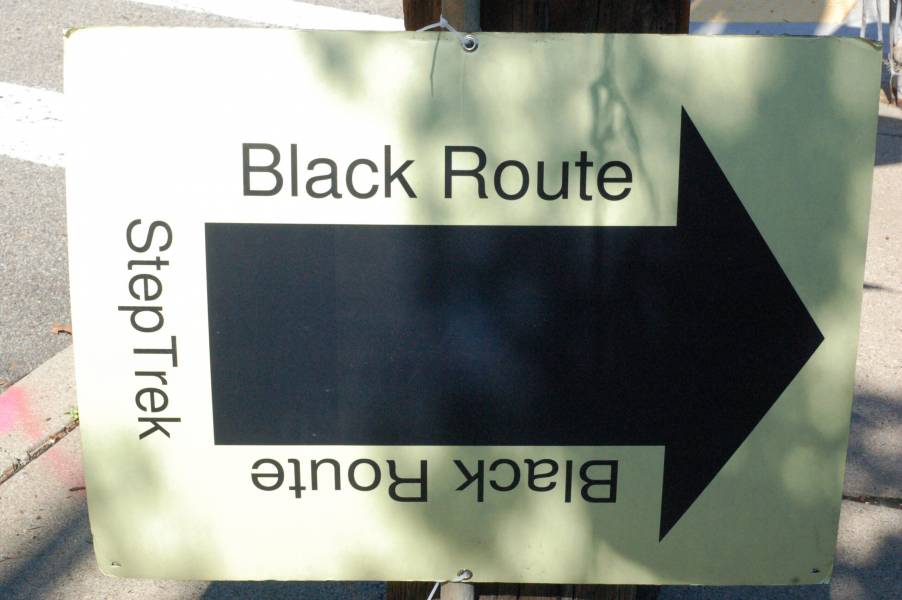 62. Black Route
62. Black RouteFrom the registration area you can join the Black Route on S. 21st St. Please see map and narrative.
From the registration area you can join the Black Route on S. 21st St. Please see map and narrative.
From the registration area you can join the Black Route on S. 21st St. Please see map and narrative.






If joining from the Black Route, begin with #5. * Denotes history or significant site.
If joining from the Black Route, begin with #5. * Denotes history or significant site.
If joining from the Black Route, begin with #5. * Denotes history or significant site.

To help celebrate StepTrek’s coming of age, five different bands will perform at various venues throughout South Side Slopes. Four of the bands boast members who live on the South Side Flats or Slopes. Performance locations and times are listed within the route narrative. Take time to enjoy a breather and some music!
To help celebrate StepTrek’s coming of age, five different bands will perform at various venues throughout South Side Slopes. Four of the bands boast members who live on the South Side Flats or Slopes. Performance locations and times are listed within the route narrative. Take time to enjoy a breather and some music!
To help celebrate StepTrek’s coming of age, five different bands will perform at various venues throughout South Side Slopes. Four of the bands boast members who live on the South Side Flats or Slopes. Performance locations and times are listed within the route narrative. Take time to enjoy a breather and some music!

Efforts continue to reclaim a 64 acre park that extends from Josephine St. below to the heights of the Slopes. In this wooded hillside are streams, ball fields and footpaths. Volunteers have removed invasive plants and helped build its trails. Helping trim the aggressive knotweed and vines are a small herd of bovids, brought in for a few weeks as part of the Annual Goat Fest. With funding from The Brashear Association, South Side Slopes Neighborhood Association partnered with Pittsburgh Parks Conservancy, Landforce and the Student Conservation Association to create this neighborhood asset. Friends of South Side Park manages its ongoing work.
Efforts continue to reclaim a 64 acre park that extends from Josephine St. below to the heights of the Slopes. In this wooded hillside are streams, ball fields and footpaths. Volunteers have removed invasive plants and helped build its trails. Helping trim the aggressive knotweed and vines are a small herd of bovids, brought in for a few weeks as part of the Annual Goat Fest. With funding from The Brashear Association, South Side Slopes Neighborhood Association partnered with Pittsburgh Parks Conservancy, Landforce and the Student Conservation Association to create this neighborhood asset. Friends of South Side Park manages its ongoing work.
Efforts continue to reclaim a 64 acre park that extends from Josephine St. below to the heights of the Slopes. In this wooded hillside are streams, ball fields and footpaths. Volunteers have removed invasive plants and helped build its trails. Helping trim the aggressive knotweed and vines are a small herd of bovids, brought in for a few weeks as part of the Annual Goat Fest. With funding from The Brashear Association, South Side Slopes Neighborhood Association partnered with Pittsburgh Parks Conservancy, Landforce and the Student Conservation Association to create this neighborhood asset. Friends of South Side Park manages its ongoing work.

Under the bridge towering over StepTrek registration and Marketplace are the Mission St. Steps. You’ll find them under the left side of the bridge. Climb a total of 102 steps to the intersection of Mission St. and S. 18th St.
Under the bridge towering over StepTrek registration and Marketplace are the Mission St. Steps. You’ll find them under the left side of the bridge. Climb a total of 102 steps to the intersection of Mission St. and S. 18th St.
Under the bridge towering over StepTrek registration and Marketplace are the Mission St. Steps. You’ll find them under the left side of the bridge. Climb a total of 102 steps to the intersection of Mission St. and S. 18th St.

Cross S. 18th St. at light to Pius St. on the opposite side.
Cross S. 18th St. at light to Pius St. on the opposite side.
Cross S. 18th St. at light to Pius St. on the opposite side.

Continue along left side of Pius. Residents are encouraged to add art in support of StepTrek. Hanging on a tree in front of 179 Pius are crystals hanging throughout and two COR-TEN steel birds in the shape of cardinal and a crow. A few of the larger brick buildings housed businesses that had storefronts on their ground floors. Just past 132 Pius St. are Yard Way Steps.
Continue along left side of Pius. Residents are encouraged to add art in support of StepTrek. Hanging on a tree in front of 179 Pius are crystals hanging throughout and two COR-TEN steel birds in the shape of cardinal and a crow. A few of the larger brick buildings housed businesses that had storefronts on their ground floors. Just past 132 Pius St. are Yard Way Steps.
Continue along left side of Pius. Residents are encouraged to add art in support of StepTrek. Hanging on a tree in front of 179 Pius are crystals hanging throughout and two COR-TEN steel birds in the shape of cardinal and a crow. A few of the larger brick buildings housed businesses that had storefronts on their ground floors. Just past 132 Pius St. are Yard Way Steps.

Most of the steps on Yard Way date back to 1944 and number 314 in total. They are the longest set of stairs on this side of the Slopes. The first 13 steps were rebuilt in time for the initial StepTrek in April 2000. In addition to providing a fascinating tour of this hillside neighborhood, StepTrek encourages the city to make repairs to existing stairways for public safety. The first cross street you come to is Gregory St.
Most of the steps on Yard Way date back to 1944 and number 314 in total. They are the longest set of stairs on this side of the Slopes. The first 13 steps were rebuilt in time for the initial StepTrek in April 2000. In addition to providing a fascinating tour of this hillside neighborhood, StepTrek encourages the city to make repairs to existing stairways for public safety. The first cross street you come to is Gregory St.
Most of the steps on Yard Way date back to 1944 and number 314 in total. They are the longest set of stairs on this side of the Slopes. The first 13 steps were rebuilt in time for the initial StepTrek in April 2000. In addition to providing a fascinating tour of this hillside neighborhood, StepTrek encourages the city to make repairs to existing stairways for public safety. The first cross street you come to is Gregory St.

Make right. Walk to end of street. Across on the right is a fire hydrant
and utility pole. Short St. steps are to the right between a fence and house.
Make right. Walk to end of street. Across on the right is a fire hydrant
and utility pole. Short St. steps are to the right between a fence and house.
Make right. Walk to end of street. Across on the right is a fire hydrant
and utility pole. Short St. steps are to the right between a fence and house.

Turn right and descend 21 steps to Pius St. You are now in the midst of the what was St. Michael Parish.
Turn right and descend 21 steps to Pius St. You are now in the midst of the what was St. Michael Parish.
Turn right and descend 21 steps to Pius St. You are now in the midst of the what was St. Michael Parish.

Make left and keep left along Pius. The former convent at 66 Pius Street,
on the left, is now a condominium complex. The building was once part of St. Michael’s
Parish.
Make left and keep left along Pius. The former convent at 66 Pius Street,
on the left, is now a condominium complex. The building was once part of St. Michael’s
Parish.
Make left and keep left along Pius. The former convent at 66 Pius Street,
on the left, is now a condominium complex. The building was once part of St. Michael’s
Parish.

At 44 Pius is the former St. Michael’s Madchen Schule and previous home of the Veronica’s Veil playhouse. The theater hosted a series of plays throughout the year but was most famous for its Passion play, Veronica’s Veil. Performed during Lent, it was said to be the longest running play in American community theater. These buildings were part of St. Michael’s Parish. The next building housed the Burning Bush, which offered a retreat center for quiet meditation in overnight rooms. Both buildings are part of a planned new apartment complex.
At 44 Pius is the former St. Michael’s Madchen Schule and previous home of the Veronica’s Veil playhouse. The theater hosted a series of plays throughout the year but was most famous for its Passion play, Veronica’s Veil. Performed during Lent, it was said to be the longest running play in American community theater. These buildings were part of St. Michael’s Parish. The next building housed the Burning Bush, which offered a retreat center for quiet meditation in overnight rooms. Both buildings are part of a planned new apartment complex.
At 44 Pius is the former St. Michael’s Madchen Schule and previous home of the Veronica’s Veil playhouse. The theater hosted a series of plays throughout the year but was most famous for its Passion play, Veronica’s Veil. Performed during Lent, it was said to be the longest running play in American community theater. These buildings were part of St. Michael’s Parish. The next building housed the Burning Bush, which offered a retreat center for quiet meditation in overnight rooms. Both buildings are part of a planned new apartment complex.

The influence of the church was strong in the Slopes. St. Michael parish started in a house in 1848 where the church front now stands. Designed by Charles Bartberger of Stuttgart, Germany, the church was built between 1855 and 1860 on land donated by German immigrants. The surrounding land reminded them of the Rhine River valley. Though it has a gothic spire, the overall style is Rhineland Romanesque Rival similar to rural Bavarian churches. The church was closed through a consolidation of parishes and has been redeveloped into condominiums.
The influence of the church was strong in the Slopes. St. Michael parish started in a house in 1848 where the church front now stands. Designed by Charles Bartberger of Stuttgart, Germany, the church was built between 1855 and 1860 on land donated by German immigrants. The surrounding land reminded them of the Rhine River valley. Though it has a gothic spire, the overall style is Rhineland Romanesque Rival similar to rural Bavarian churches. The church was closed through a consolidation of parishes and has been redeveloped into condominiums.
The influence of the church was strong in the Slopes. St. Michael parish started in a house in 1848 where the church front now stands. Designed by Charles Bartberger of Stuttgart, Germany, the church was built between 1855 and 1860 on land donated by German immigrants. The surrounding land reminded them of the Rhine River valley. Though it has a gothic spire, the overall style is Rhineland Romanesque Rival similar to rural Bavarian churches. The church was closed through a consolidation of parishes and has been redeveloped into condominiums.

Make right before St. Michael Church and descend the 26 steps along left side to Clinton St.
Make right before St. Michael Church and descend the 26 steps along left side to Clinton St.
Make right before St. Michael Church and descend the 26 steps along left side to Clinton St.

Continue past Clinton to set of steps dropping through the trees. Descend the 60 stairs to the footbridge over the Norfolk Southern Railroad.
Continue past Clinton to set of steps dropping through the trees. Descend the 60 stairs to the footbridge over the Norfolk Southern Railroad.
Continue past Clinton to set of steps dropping through the trees. Descend the 60 stairs to the footbridge over the Norfolk Southern Railroad.

At the request of SSSNA & Slopes residents, the City and railroad completed this footbridge and the other at S. 10th St. in 2002. The trestle is made of the same COR-TEN steel as the UPMC (former U.S. Steel) tower downtown. The brown rust serves as a protective coating over the steel frame. The bridges reinstated pedestrian access between the Slopes and Flats. Another SSSNA effort brought safety lighting to the two bridges. At the end of the bridge, descend 59 steps.
At the request of SSSNA & Slopes residents, the City and railroad completed this footbridge and the other at S. 10th St. in 2002. The trestle is made of the same COR-TEN steel as the UPMC (former U.S. Steel) tower downtown. The brown rust serves as a protective coating over the steel frame. The bridges reinstated pedestrian access between the Slopes and Flats. Another SSSNA effort brought safety lighting to the two bridges. At the end of the bridge, descend 59 steps.
At the request of SSSNA & Slopes residents, the City and railroad completed this footbridge and the other at S. 10th St. in 2002. The trestle is made of the same COR-TEN steel as the UPMC (former U.S. Steel) tower downtown. The brown rust serves as a protective coating over the steel frame. The bridges reinstated pedestrian access between the Slopes and Flats. Another SSSNA effort brought safety lighting to the two bridges. At the end of the bridge, descend 59 steps.

To the right is the former Polska Szkola built in 1898. Continue down S. 15th St. one half block to Breed St. A couple of doors down S. 15th St., on the left, is St. Adalbert Church. This is the sole active Roman Catholic church in the South Side since the consolidation among local parishes.
To the right is the former Polska Szkola built in 1898. Continue down S. 15th St. one half block to Breed St. A couple of doors down S. 15th St., on the left, is St. Adalbert Church. This is the sole active Roman Catholic church in the South Side since the consolidation among local parishes.
To the right is the former Polska Szkola built in 1898. Continue down S. 15th St. one half block to Breed St. A couple of doors down S. 15th St., on the left, is St. Adalbert Church. This is the sole active Roman Catholic church in the South Side since the consolidation among local parishes.

Make left and walk along this shady street of mostly brick houses to S. 12th St.
Make left and walk along this shady street of mostly brick houses to S. 12th St.
Make left and walk along this shady street of mostly brick houses to S. 12th St.

Take a right and keep right as you walk to Freyburg St.
Take a right and keep right as you walk to Freyburg St.
Take a right and keep right as you walk to Freyburg St.

Use caution as you make left and cross S. 12th St. Between 1117 and 1111 Freyburg was where a stone wall vaulted the Knoxville Incline over Freyburg on its climb to the hilltop. Its foundation remains.
Use caution as you make left and cross S. 12th St. Between 1117 and 1111 Freyburg was where a stone wall vaulted the Knoxville Incline over Freyburg on its climb to the hilltop. Its foundation remains.
Use caution as you make left and cross S. 12th St. Between 1117 and 1111 Freyburg was where a stone wall vaulted the Knoxville Incline over Freyburg on its climb to the hilltop. Its foundation remains.

The Knoxville Incline (1889-1960) began one street down on Bradish St. It followed the hollow going uphill to Fritz St. and Allentown. A deep trough carved into the ground permitted the incline to dock at street level. Later renamed the Pittsburgh Incline, it boarded horses, wagons, carts and passengers and was the last remaining of two city inclines to curve up the hill. The track extended 2,644 feet and was the longest incline in the city. During the Depression, it cost three cents to ride. Continue on Freyburg to S. 10th St.
The Knoxville Incline (1889-1960) began one street down on Bradish St. It followed the hollow going uphill to Fritz St. and Allentown. A deep trough carved into the ground permitted the incline to dock at street level. Later renamed the Pittsburgh Incline, it boarded horses, wagons, carts and passengers and was the last remaining of two city inclines to curve up the hill. The track extended 2,644 feet and was the longest incline in the city. During the Depression, it cost three cents to ride. Continue on Freyburg to S. 10th St.
The Knoxville Incline (1889-1960) began one street down on Bradish St. It followed the hollow going uphill to Fritz St. and Allentown. A deep trough carved into the ground permitted the incline to dock at street level. Later renamed the Pittsburgh Incline, it boarded horses, wagons, carts and passengers and was the last remaining of two city inclines to curve up the hill. The track extended 2,644 feet and was the longest incline in the city. During the Depression, it cost three cents to ride. Continue on Freyburg to S. 10th St.

Make left and climb 57 steps to S. 10th St. Pedestrian Bridge, a sister to S. 15th St. Bridge, erected in the same year. Stop mid-span and look left to view the spectacular St. Michael church on the hillside. Continue across the railroad tracks and climb 49 steps to Fritz St.
Make left and climb 57 steps to S. 10th St. Pedestrian Bridge, a sister to S. 15th St. Bridge, erected in the same year. Stop mid-span and look left to view the spectacular St. Michael church on the hillside. Continue across the railroad tracks and climb 49 steps to Fritz St.
Make left and climb 57 steps to S. 10th St. Pedestrian Bridge, a sister to S. 15th St. Bridge, erected in the same year. Stop mid-span and look left to view the spectacular St. Michael church on the hillside. Continue across the railroad tracks and climb 49 steps to Fritz St.

Make right and walk 50 feet to German Square.
Make right and walk 50 feet to German Square.
Make right and walk 50 feet to German Square.

Named after the German families who settled on the hillside, the square features parallel sets of steps that climb into the Slopes.
Named after the German families who settled on the hillside, the square features parallel sets of steps that climb into the Slopes.
Named after the German families who settled on the hillside, the square features parallel sets of steps that climb into the Slopes.

Go to the stairway on the right and climb the 128 steps, which hook to the right, and lead to Newton St.
Go to the stairway on the right and climb the 128 steps, which hook to the right, and lead to Newton St.
Go to the stairway on the right and climb the 128 steps, which hook to the right, and lead to Newton St.

Continue along the foot path to the narrow lane and Lauer Way Steps. Notice the beautiful views of South Side and downtown. That’s South Side Stadium directly below.
Continue along the foot path to the narrow lane and Lauer Way Steps. Notice the beautiful views of South Side and downtown. That’s South Side Stadium directly below.
Continue along the foot path to the narrow lane and Lauer Way Steps. Notice the beautiful views of South Side and downtown. That’s South Side Stadium directly below.

Take a left and climb 95 steps to Arlington Ave.
Take a left and climb 95 steps to Arlington Ave.
Take a left and climb 95 steps to Arlington Ave.

Make left and ascend Arlington two blocks. Pass Behring St. and round the corner where you’ll find Hartford St. The trolley tracks link Station Square below with Allentown, a hilltop community.
Make left and ascend Arlington two blocks. Pass Behring St. and round the corner where you’ll find Hartford St. The trolley tracks link Station Square below with Allentown, a hilltop community.
Make left and ascend Arlington two blocks. Pass Behring St. and round the corner where you’ll find Hartford St. The trolley tracks link Station Square below with Allentown, a hilltop community.

Take a left and descend the narrow, curvy lane. Stay right and descend 27 steps. Continue to end of street and steps. That’s St. Paul of the Cross Monastery high on the hill across the ravine.
Take a left and descend the narrow, curvy lane. Stay right and descend 27 steps. Continue to end of street and steps. That’s St. Paul of the Cross Monastery high on the hill across the ravine.
Take a left and descend the narrow, curvy lane. Stay right and descend 27 steps. Continue to end of street and steps. That’s St. Paul of the Cross Monastery high on the hill across the ravine.

Make left and descend 70 wooden steps to Fritz St.
Make left and descend 70 wooden steps to Fritz St.
Make left and descend 70 wooden steps to Fritz St.

Turn right. The trail follows what was Fritz St. It’s hard to believe you’re in the city! Be careful as you walk Knoxville Incline Trail to Brosville St.
Turn right. The trail follows what was Fritz St. It’s hard to believe you’re in the city! Be careful as you walk Knoxville Incline Trail to Brosville St.
Turn right. The trail follows what was Fritz St. It’s hard to believe you’re in the city! Be careful as you walk Knoxville Incline Trail to Brosville St.

A gravel, timber-lined foot trail marks the entrance from Brosville. A bridge crosses over where the Knoxville Incline ran from 1890 to 1960. Over the years, SSSNA members have pulled several hundred tires from the ravine as part of an area clean up. Now a parklet honors its history. From the right side of bridge you can see heavy stone retaining walls and the trough through which the incline rode. The Greenway was created in 2016 in partnership with GTECH Strategies as part of its ReClaim South program. It continues down the Welsh Way stairs. The project is on the border with Allentown and Allentown CDC donated the trees planted in the parklet.
A gravel, timber-lined foot trail marks the entrance from Brosville. A bridge crosses over where the Knoxville Incline ran from 1890 to 1960. Over the years, SSSNA members have pulled several hundred tires from the ravine as part of an area clean up. Now a parklet honors its history. From the right side of bridge you can see heavy stone retaining walls and the trough through which the incline rode. The Greenway was created in 2016 in partnership with GTECH Strategies as part of its ReClaim South program. It continues down the Welsh Way stairs. The project is on the border with Allentown and Allentown CDC donated the trees planted in the parklet.
A gravel, timber-lined foot trail marks the entrance from Brosville. A bridge crosses over where the Knoxville Incline ran from 1890 to 1960. Over the years, SSSNA members have pulled several hundred tires from the ravine as part of an area clean up. Now a parklet honors its history. From the right side of bridge you can see heavy stone retaining walls and the trough through which the incline rode. The Greenway was created in 2016 in partnership with GTECH Strategies as part of its ReClaim South program. It continues down the Welsh Way stairs. The project is on the border with Allentown and Allentown CDC donated the trees planted in the parklet.

Take a left and keep left as you descend Brosville. That’s Allentown up hill to the right. Walk down Brosville a few hundred yards to Welcome Garden at Monastery St.
Take a left and keep left as you descend Brosville. That’s Allentown up hill to the right. Walk down Brosville a few hundred yards to Welcome Garden at Monastery St.
Take a left and keep left as you descend Brosville. That’s Allentown up hill to the right. Walk down Brosville a few hundred yards to Welcome Garden at Monastery St.

Terraced into the hillside on the right is a quiet green space. The fabricated canvas of COR-TEN steel plate was created by former SSSNA board member and architect Peter Kreuthmeier and installed against a curved retaining wall. The scrim replicates a section of a Slopes neighborhood from a lot and block map. An Elm Street project funded by the state, it was dedicated in 2007 and is one of six gardens maintained by SSSNA members. The installation has garnered both state and local awards.
Terraced into the hillside on the right is a quiet green space. The fabricated canvas of COR-TEN steel plate was created by former SSSNA board member and architect Peter Kreuthmeier and installed against a curved retaining wall. The scrim replicates a section of a Slopes neighborhood from a lot and block map. An Elm Street project funded by the state, it was dedicated in 2007 and is one of six gardens maintained by SSSNA members. The installation has garnered both state and local awards.
Terraced into the hillside on the right is a quiet green space. The fabricated canvas of COR-TEN steel plate was created by former SSSNA board member and architect Peter Kreuthmeier and installed against a curved retaining wall. The scrim replicates a section of a Slopes neighborhood from a lot and block map. An Elm Street project funded by the state, it was dedicated in 2007 and is one of six gardens maintained by SSSNA members. The installation has garnered both state and local awards.

Be careful as you cross Brosville to Hackstown St. Directly ahead are St. Joseph Way Steps. Ascend the 76 steps to St. Joseph Way. Note that the first few houses have access via the steps only. Ascend the 76 steps to St. Joseph Way. Note that the first few houses have access via the steps only.
Be careful as you cross Brosville to Hackstown St. Directly ahead are St. Joseph Way Steps. Ascend the 76 steps to St. Joseph Way. Note that the first few houses have access via the steps only. Ascend the 76 steps to St. Joseph Way. Note that the first few houses have access via the steps only.
Be careful as you cross Brosville to Hackstown St. Directly ahead are St. Joseph Way Steps. Ascend the 76 steps to St. Joseph Way. Note that the first few houses have access via the steps only. Ascend the 76 steps to St. Joseph Way. Note that the first few houses have access via the steps only.

Make right and climb 5 steps on the way to Monastery St.
Make right and climb 5 steps on the way to Monastery St.
Make right and climb 5 steps on the way to Monastery St.

You are now following part of the Church Route. The Church Route is a walking tour that goes up and down our unique stairways providing beautiful views of the city, and featuring glimpses of the eccentric hillside architecture and historic churches. For 10 years this route was a part of the SSSNA’s annual StepTrek but the association decided to formalize the route into a permanently signed walk instead. Funding for the signage was provided by the SSSNA in partnership with the City of Pittsburgh, who manufactured and installed the wayfinding signs.
You are now following part of the Church Route. The Church Route is a walking tour that goes up and down our unique stairways providing beautiful views of the city, and featuring glimpses of the eccentric hillside architecture and historic churches. For 10 years this route was a part of the SSSNA’s annual StepTrek but the association decided to formalize the route into a permanently signed walk instead. Funding for the signage was provided by the SSSNA in partnership with the City of Pittsburgh, who manufactured and installed the wayfinding signs.
You are now following part of the Church Route. The Church Route is a walking tour that goes up and down our unique stairways providing beautiful views of the city, and featuring glimpses of the eccentric hillside architecture and historic churches. For 10 years this route was a part of the SSSNA’s annual StepTrek but the association decided to formalize the route into a permanently signed walk instead. Funding for the signage was provided by the SSSNA in partnership with the City of Pittsburgh, who manufactured and installed the wayfinding signs.

Cross street and make left to ascend 15 steps on the right side. These steps and sidewalk were rebuilt a few years ago as part of a project to replace a larger set of steps that ran the length of Monastery. At the top lies the historical St. Paul of the Cross Monastery.
Cross street and make left to ascend 15 steps on the right side. These steps and sidewalk were rebuilt a few years ago as part of a project to replace a larger set of steps that ran the length of Monastery. At the top lies the historical St. Paul of the Cross Monastery.
Cross street and make left to ascend 15 steps on the right side. These steps and sidewalk were rebuilt a few years ago as part of a project to replace a larger set of steps that ran the length of Monastery. At the top lies the historical St. Paul of the Cross Monastery.

Known as the barefoot missionaries, the Passionists vowed to live a life of prayer, poverty, penance and solitude. The first bishop of Pittsburgh invited the Italian order over in 1852. Designed by the architect Charles Bartberger, who also designed St. Michael Church, the church was completed in 1859 in the midst of an 11 acre compound chosen for its serenity, natural beauty and seclusion. The architectural style is Romanesque. The interior rose window is a copy of one in Reims, Germany. The newly renovated chapel is exquisite and opens daily from 7 a.m. to 5 p.m. Please step inside for quiet observation. On exiting the chapel, take in the stunning view of downtown.
Known as the barefoot missionaries, the Passionists vowed to live a life of prayer, poverty, penance and solitude. The first bishop of Pittsburgh invited the Italian order over in 1852. Designed by the architect Charles Bartberger, who also designed St. Michael Church, the church was completed in 1859 in the midst of an 11 acre compound chosen for its serenity, natural beauty and seclusion. The architectural style is Romanesque. The interior rose window is a copy of one in Reims, Germany. The newly renovated chapel is exquisite and opens daily from 7 a.m. to 5 p.m. Please step inside for quiet observation. On exiting the chapel, take in the stunning view of downtown.
Known as the barefoot missionaries, the Passionists vowed to live a life of prayer, poverty, penance and solitude. The first bishop of Pittsburgh invited the Italian order over in 1852. Designed by the architect Charles Bartberger, who also designed St. Michael Church, the church was completed in 1859 in the midst of an 11 acre compound chosen for its serenity, natural beauty and seclusion. The architectural style is Romanesque. The interior rose window is a copy of one in Reims, Germany. The newly renovated chapel is exquisite and opens daily from 7 a.m. to 5 p.m. Please step inside for quiet observation. On exiting the chapel, take in the stunning view of downtown.

From the top of Monastery St., make a right and descend along right side of Monastery Ave. to S. 18th St.
From the top of Monastery St., make a right and descend along right side of Monastery Ave. to S. 18th St.
From the top of Monastery St., make a right and descend along right side of Monastery Ave. to S. 18th St.

Take a right and walk up S. 18th to St. Thomas St. Steps. Quarry St. is on the left, across from entrance to the steps.
Take a right and walk up S. 18th to St. Thomas St. Steps. Quarry St. is on the left, across from entrance to the steps.
Take a right and walk up S. 18th to St. Thomas St. Steps. Quarry St. is on the left, across from entrance to the steps.

Make right and climb 44 steps and turn right at landing. Follow the red railing and drop two steps. Make a left and climb sidewalk that leads to St. Thomas St. Continue up 4 steps in sidewalk to Angelo St.
Make right and climb 44 steps and turn right at landing. Follow the red railing and drop two steps. Make a left and climb sidewalk that leads to St. Thomas St. Continue up 4 steps in sidewalk to Angelo St.
Make right and climb 44 steps and turn right at landing. Follow the red railing and drop two steps. Make a left and climb sidewalk that leads to St. Thomas St. Continue up 4 steps in sidewalk to Angelo St.

Take left and climb 5 steps. Keep left and continue past Wachter St. with its view of St. Michael Cemetery on the hill to the left. At next street, make left onto Rugraff St.
Take left and climb 5 steps. Keep left and continue past Wachter St. with its view of St. Michael Cemetery on the hill to the left. At next street, make left onto Rugraff St.
Take left and climb 5 steps. Keep left and continue past Wachter St. with its view of St. Michael Cemetery on the hill to the left. At next street, make left onto Rugraff St.

The Slopes neighborhood possesses quiet, sometimes forgotten, alleys that provide respite and seclusion from the city. Rugraff provides views to the left of wooded hillsides and distant houses. To the right, perched over the slopes, rise tall, tightly packed houses. Continue to 18th St. and the colorful, hillside mural.
The Slopes neighborhood possesses quiet, sometimes forgotten, alleys that provide respite and seclusion from the city. Rugraff provides views to the left of wooded hillsides and distant houses. To the right, perched over the slopes, rise tall, tightly packed houses. Continue to 18th St. and the colorful, hillside mural.
The Slopes neighborhood possesses quiet, sometimes forgotten, alleys that provide respite and seclusion from the city. Rugraff provides views to the left of wooded hillsides and distant houses. To the right, perched over the slopes, rise tall, tightly packed houses. Continue to 18th St. and the colorful, hillside mural.

Nearly everyone on the Slopes has a retaining wall. They are a function of the steep terrain and the residents’ desire to make the most use of their land. A state grant in 2004 turned this retaining wall into a work of art. Unfortunately, seeping water has taken its toll on the mural. Its timeline starts in the 1850s when South Side existed as a separate town called Birmingham. Created by Richard Bach, the mural depicts the varied character of South Side, its love of music and athletics, hard-work and fun.
Nearly everyone on the Slopes has a retaining wall. They are a function of the steep terrain and the residents’ desire to make the most use of their land. A state grant in 2004 turned this retaining wall into a work of art. Unfortunately, seeping water has taken its toll on the mural. Its timeline starts in the 1850s when South Side existed as a separate town called Birmingham. Created by Richard Bach, the mural depicts the varied character of South Side, its love of music and athletics, hard-work and fun.
Nearly everyone on the Slopes has a retaining wall. They are a function of the steep terrain and the residents’ desire to make the most use of their land. A state grant in 2004 turned this retaining wall into a work of art. Unfortunately, seeping water has taken its toll on the mural. Its timeline starts in the 1850s when South Side existed as a separate town called Birmingham. Created by Richard Bach, the mural depicts the varied character of South Side, its love of music and athletics, hard-work and fun.

Be careful as you cross S. 18th St. to Quarry St. Walk this quirky lane that starts at the top of a vale that descends through the Slopes. Continue along Quarry to where it ends at steps.
Be careful as you cross S. 18th St. to Quarry St. Walk this quirky lane that starts at the top of a vale that descends through the Slopes. Continue along Quarry to where it ends at steps.
Be careful as you cross S. 18th St. to Quarry St. Walk this quirky lane that starts at the top of a vale that descends through the Slopes. Continue along Quarry to where it ends at steps.

At street’s end, turn right and descend 32 steps.
At street’s end, turn right and descend 32 steps.
At street’s end, turn right and descend 32 steps.

At the bottom of the steps turn left, where you again pick up Quarry St. Continue walking forward and keep right to join Gable St. Keeping right, follow to its end at St. Patrick St.
At the bottom of the steps turn left, where you again pick up Quarry St. Continue walking forward and keep right to join Gable St. Keeping right, follow to its end at St. Patrick St.
At the bottom of the steps turn left, where you again pick up Quarry St. Continue walking forward and keep right to join Gable St. Keeping right, follow to its end at St. Patrick St.

Make left and descend St. Patrick. Continue past Saber Way and ascend toward S. 18th St. Take the last five steps on left to S. 18th St.
Make left and descend St. Patrick. Continue past Saber Way and ascend toward S. 18th St. Take the last five steps on left to S. 18th St.
Make left and descend St. Patrick. Continue past Saber Way and ascend toward S. 18th St. Take the last five steps on left to S. 18th St.

Use caution in crossing S. 18th Street to steps on opposite side. Ascend the 82 steps to St. Paul St.
Use caution in crossing S. 18th Street to steps on opposite side. Ascend the 82 steps to St. Paul St.
Use caution in crossing S. 18th Street to steps on opposite side. Ascend the 82 steps to St. Paul St.

At top of steps, notice the brick garden wall to the far left. It is part of the St. Paul of the Cross Monastery and Retreat Center. The wall appear to be the original one that shielded the enclave from the outside world. The garden features the Stations of the Cross which can be seen through the metal fencing opposite the steps. Turn right. Follow St. Paul to Yard Way. Welcome to Billy Buck Hill!
At top of steps, notice the brick garden wall to the far left. It is part of the St. Paul of the Cross Monastery and Retreat Center. The wall appear to be the original one that shielded the enclave from the outside world. The garden features the Stations of the Cross which can be seen through the metal fencing opposite the steps. Turn right. Follow St. Paul to Yard Way. Welcome to Billy Buck Hill!
At top of steps, notice the brick garden wall to the far left. It is part of the St. Paul of the Cross Monastery and Retreat Center. The wall appear to be the original one that shielded the enclave from the outside world. The garden features the Stations of the Cross which can be seen through the metal fencing opposite the steps. Turn right. Follow St. Paul to Yard Way. Welcome to Billy Buck Hill!
Founded by Germans, its homes – like many on the South Side – have passed through generations of families. The name Billy Buck comes from goats once kept in the yard of a local store. Bordered by cliffs and rugged terrain, the area is accessible by steps and a single street. According to the Post-Gazette, there have been a couple of famous mishaps here. Once a milk truck flipped over while making deliveries on its hilly streets. Another time, a horse and wagon, hauling waste from neighborhood outhouses, tumbled over the hillside.
Founded by Germans, its homes – like many on the South Side – have passed through generations of families. The name Billy Buck comes from goats once kept in the yard of a local store. Bordered by cliffs and rugged terrain, the area is accessible by steps and a single street. According to the Post-Gazette, there have been a couple of famous mishaps here. Once a milk truck flipped over while making deliveries on its hilly streets. Another time, a horse and wagon, hauling waste from neighborhood outhouses, tumbled over the hillside.
Founded by Germans, its homes – like many on the South Side – have passed through generations of families. The name Billy Buck comes from goats once kept in the yard of a local store. Bordered by cliffs and rugged terrain, the area is accessible by steps and a single street. According to the Post-Gazette, there have been a couple of famous mishaps here. Once a milk truck flipped over while making deliveries on its hilly streets. Another time, a horse and wagon, hauling waste from neighborhood outhouses, tumbled over the hillside.

Make a left on Yard Way and walk to Shamokin St. View uptown, Oakland and Greenfield across the river. South Side Works, on the site of the former LTV site, sits to the bottom right.
Make a left on Yard Way and walk to Shamokin St. View uptown, Oakland and Greenfield across the river. South Side Works, on the site of the former LTV site, sits to the bottom right.
Make a left on Yard Way and walk to Shamokin St. View uptown, Oakland and Greenfield across the river. South Side Works, on the site of the former LTV site, sits to the bottom right.

Built in 1944, the steps drop a total of 301 stairs to Pius St. below. Cross Shamokin and descend 63 of them to Huron St. and the temporarily closed Winters Playground. It is one of a series of parklets dotting the hillside. If you complete both routes, you will pass three of them.
Built in 1944, the steps drop a total of 301 stairs to Pius St. below. Cross Shamokin and descend 63 of them to Huron St. and the temporarily closed Winters Playground. It is one of a series of parklets dotting the hillside. If you complete both routes, you will pass three of them.
Built in 1944, the steps drop a total of 301 stairs to Pius St. below. Cross Shamokin and descend 63 of them to Huron St. and the temporarily closed Winters Playground. It is one of a series of parklets dotting the hillside. If you complete both routes, you will pass three of them.

Make right. This dead-end street is pitched high in the Slopes with lovely view below.
Make right. This dead-end street is pitched high in the Slopes with lovely view below.
Make right. This dead-end street is pitched high in the Slopes with lovely view below.

Make left and descend to Oporto St. Steps. A landslide this past spring has closed Oporto to the south and right of you. The neighborhood is in a constant negotiation with the city to maintain the infrastructure of its hillside community.
Make left and descend to Oporto St. Steps. A landslide this past spring has closed Oporto to the south and right of you. The neighborhood is in a constant negotiation with the city to maintain the infrastructure of its hillside community.
Make left and descend to Oporto St. Steps. A landslide this past spring has closed Oporto to the south and right of you. The neighborhood is in a constant negotiation with the city to maintain the infrastructure of its hillside community.

Descend 10 steps and turn right. Begin descending the 115 steps to Roscoe St. To the right of the steps was the site of the Sankey brick yard that was active in the Slopes until the 1950s. Many a yard in the slopes has a stash of Sankey bricks buried under the soil.
Descend 10 steps and turn right. Begin descending the 115 steps to Roscoe St. To the right of the steps was the site of the Sankey brick yard that was active in the Slopes until the 1950s. Many a yard in the slopes has a stash of Sankey bricks buried under the soil.
Descend 10 steps and turn right. Begin descending the 115 steps to Roscoe St. To the right of the steps was the site of the Sankey brick yard that was active in the Slopes until the 1950s. Many a yard in the slopes has a stash of Sankey bricks buried under the soil.

At bottom of steps, cross lane and make right on Roscoe St. Ascend 8 steps on left side. Continue past Crossman St. to St. Leo St. Notice the tight yards on the right.
At bottom of steps, cross lane and make right on Roscoe St. Ascend 8 steps on left side. Continue past Crossman St. to St. Leo St. Notice the tight yards on the right.
At bottom of steps, cross lane and make right on Roscoe St. Ascend 8 steps on left side. Continue past Crossman St. to St. Leo St. Notice the tight yards on the right.

Turn right and continue past century-old brick homes to where street meets Crossman St.
Turn right and continue past century-old brick homes to where street meets Crossman St.
Turn right and continue past century-old brick homes to where street meets Crossman St.

Look up. You are now directly below the Oporto Street landslide. Make left and follow street to S. 18th St.
Look up. You are now directly below the Oporto Street landslide. Make left and follow street to S. 18th St.
Look up. You are now directly below the Oporto Street landslide. Make left and follow street to S. 18th St.

Cross to opposite side and turn right. Walk 40 feet to entrance to South Side Park and walk down Kimbol St. into the park.
Cross to opposite side and turn right. Walk 40 feet to entrance to South Side Park and walk down Kimbol St. into the park.
Cross to opposite side and turn right. Walk 40 feet to entrance to South Side Park and walk down Kimbol St. into the park.

Make a left and descend these 72 serpentine steps, grouped together in sets of three, to top of S. 21st St. Follow paved road on left down to the registration area where you started. The trees on the right were planted in 2013 by SSSNA.
Make a left and descend these 72 serpentine steps, grouped together in sets of three, to top of S. 21st St. Follow paved road on left down to the registration area where you started. The trees on the right were planted in 2013 by SSSNA.
Make a left and descend these 72 serpentine steps, grouped together in sets of three, to top of S. 21st St. Follow paved road on left down to the registration area where you started. The trees on the right were planted in 2013 by SSSNA.

From the registration area you can join the Black Route on S. 21st St. Please see map and narrative.
From the registration area you can join the Black Route on S. 21st St. Please see map and narrative.
From the registration area you can join the Black Route on S. 21st St. Please see map and narrative.
For Gold/West Route text, click here.
